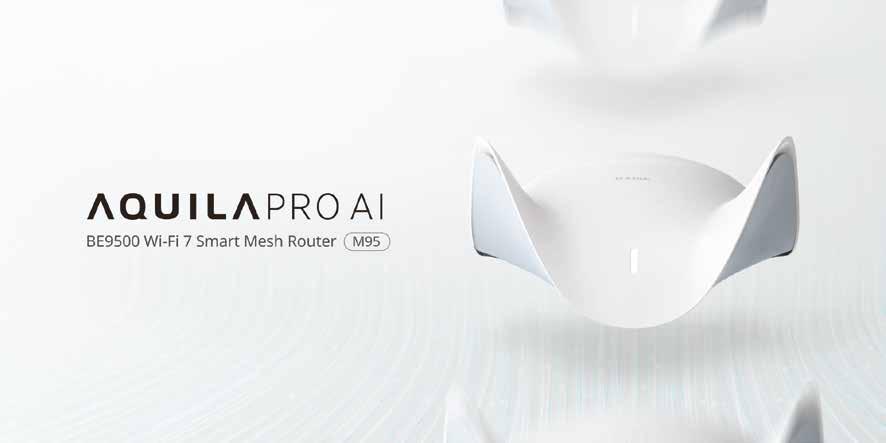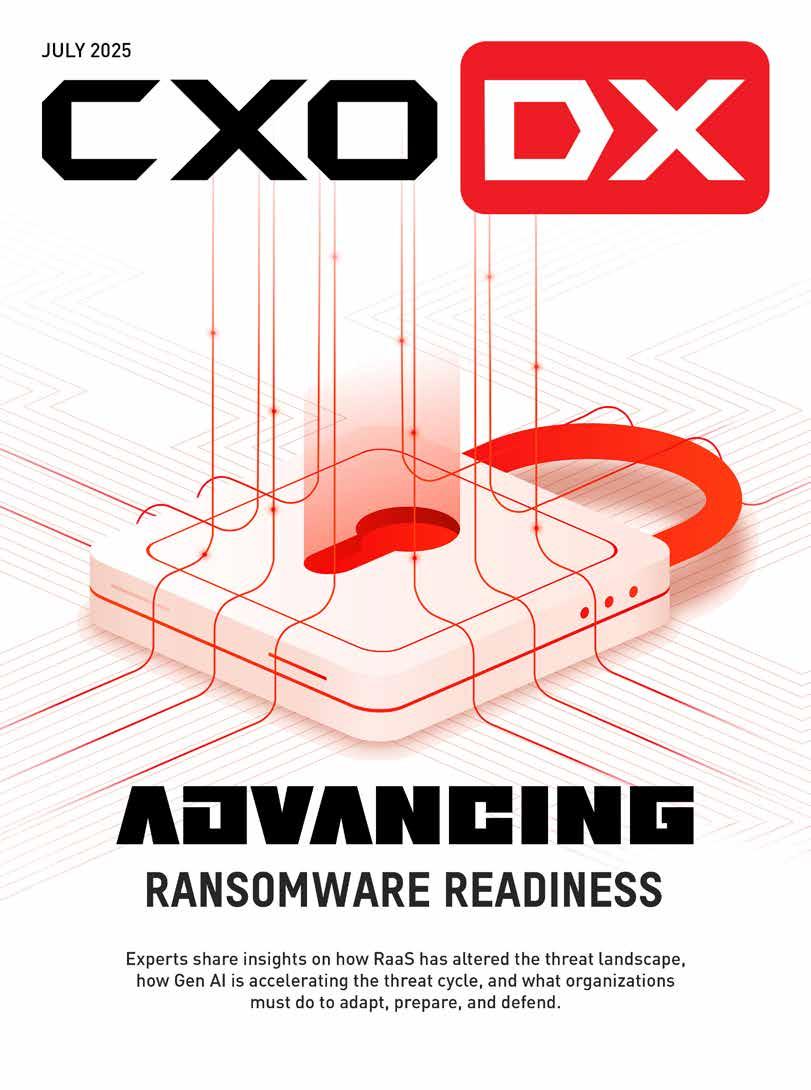






















Cybersecurity is no longer about reacting to threats. It is about anticipating and neutralizing them before they disrupt business or compromise critical infrastructure. Building resilience into IT infrastructure is no longer optional, rather it’s foundational.
In our cover story on ransomware, experts underscore a shift in thinking, from purely reactive defense to intelligent prevention and resilient recovery architectures. The interview with Halcyon reveals that ransomware is no longer seen as just a malware problem; it’s a systemic business risk. Halcyon, in particular, is doubling down on prevention-first architecture, combining endpoint protection and SaaS-based console management, while preparing to integrate agentic AI to enhance defense against fast-evolving threats.
On another front, Operational Technology (OT) security is gaining long-overdue attention. The interview with Positive Technologies outlines how the company, known for protecting critical infrastructure in Russia, is expanding its proven IT and OT expertise into the Middle East. With attacks on oil, gas, transport, and government systems on the rise, the company sees the region as ripe for strategic investments in end-to-end infrastructure security.
Advanced Persistent Threats (APTs) remain a growing concern, accounting for 32% of cyberattacks last year. These aren’t just about data theft. They raise concerns about cyberespionage, disruption, and psychological pressure. Deep detection and long-term threat intelligence are becoming essential weapons in this fight.
In the mobile domain, Ermetix brings a unique approach, unifying UEM and MTD into a single platform. Their OS-first approach, securing Android and iOS across all form factors, acknowledges a critical reality that cyber threats are form-factor agnostic and don’t care whether it is a phone or a thermostat. It’s the operating system that’s vulnerable.
From ransomware and APTs to mobile and OT protection, this issue reflects a regional cybersecurity mindset shift from fragmented defence to integrated, intelligent resilience.
RAMAN NARAYAN
Co-Founder & Editor in Chief narayan@leapmediallc.com Mob: +971-55-7802403
Sunil Kumar Designer
R. Narayan Editor in Chief, CXO DX
SAUMYADEEP HALDER
Co-Founder & MD saumyadeep@leapmediallc.com Mob: +971-54-4458401
Nihal Shetty Webmaster
MALLIKA REGO
Co-Founder & Director Client Solutions mallika@leapmediallc.com Mob: +971-50-2489676
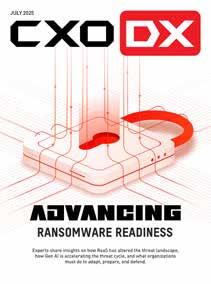
14
Experts share insights on how RaaS has altered the threat landscape, how Gen AI is accelerating the threat cycle, and what organizations must do to adapt, prepare, and defend.
Diego Fasano, CEO of Ermetix, outlines the company’s strategy, use of AI, vertical focus, and long-term regional commitment.
Alex McMullan, Vice President, CTO International at Pure Storage discusses the growing awareness among IT decision makers to enhance existing infrastructure to effectively support the increasing demands of AI deployments
Ray Kafity, Vice President of Middle East, Turkey & Africa, Halcyon outlines the company’s distinct prevention-first strategy
Ilya Leonov, Regional Director for Positive Technologies in the UAE and Middle East highlights its dual strength in OT and IT cybersecurity
Hany Mosbeh (Don), Senior Vice President – MEAPAC, JAGGAER discusses the Transformative Impact of eInvoicing on Business
Ahmad Ghandour, Regional VP - Middle East at Backbase discusses the recently launched Backbase AI-powered banking platform
Firas Jadalla, Regional Director – Middle East, Turkey & Africa, Genetec Inc. discusses how unified security platforms are playing a key role in transforming property management across the Middle East
Antoinette Hodes, Global Solutions Architect & Evangelist, Office of the CTO, Check Point Software Technologies discusses the challenges to fully securing autonomous Industrial Systems
David Warburton, Director, F5 Labs discusses 3 trends to protect against




The addition of SentinelOne’s AI detection capabilities equips OPSWAT customers with faster detection and better coverage across modern infrastructure
OPSWAT, a global leader in critical infrastructure protection, and SentinelOne announced their OEM partnership with the integration of SentinelOne’s industry-leading AI-powered detection capabilities into OPSWAT’s Metascan Multiscanning technology. This collaboration elevates malware detection across platforms, empowering enterprises to combat modern cyber threats with even greater precision and speed.
With SentinelOne’s AI/ML detection capabilities now part of OPSWAT’s Metascan Multiscanning, joint customers benefit from:
• Enhanced detection accuracy through industry-leading AI capabilities
• Cross-platform functionality, supporting both Windows and Linux deployments
• Stronger ransomware and zero-day threat defense with autonomous, cloud-independent operation
"OPSWAT's mission is to ensure the secure and compliant flow of data across
the world’s critical infrastructure," said Benny Czarny, Founder and CEO of OPSWAT. "Integrating SentinelOne’s AI detections strengthens Metascan’s multilayered defense, giving our customers faster, smarter protection against today’s most sophisticated threats."
The inclusion of SentinelOne’s AI/ML detections in Metascan Multiscanning provides unmatched malware detection through simultaneous scanning with over 30 leading anti-malware engines, utilizing signature, heuristic, and machine learning techniques to achieve over 99% detection accuracy. The inclusion of SentinelOne’s AI/ML detections further amplifies this capability by identifying threats that bypass traditional defenses, such as polymorphic malware.
“Our collaboration with OPSWAT reflects a shared commitment to strengthening cybersecurity through innovation,” said Melissa K. Smith, vice president, strategic technology partnerships and initiatives, SentinelOne. “By integrating our AI/ML
Redington to leverage AWS Marketplace's Channel Partner Private Offer (CPPO) program for customers
Redington, a leading technology aggregator and innovation powerhouse across emerging markets, has signed a Master Partner Agreement with GitLab, the most comprehensive, intelligent DevSecOps platform.
As part of the agreement, GitLab authorizes Redington to leverage AWS Marketplace's Channel Partner Private Offer (CPPO) program for customers in the Middle East and Africa, enabling Redington to receive wholesale pricing for GitLab while maintaining direct financial and contractual relationships with customers.
Redington can now sell GitLab licenses while providing customers with localized
support and specialized expertise. This collaboration enables customers to purchase GitLab's DevSecOps platform through the AWS Marketplace Management Portal, providing a seamless purchasing experience.
“This partnership strengthens our commitment to delivering cloud-native, AI-powered solutions that drive speed, security, and innovation,” said Nehal Sharma, Vice President, Cloud Solutions Group, Redington. “By offering GitLab’s comprehensive DevSecOps platform with AWS infrastructure and our channel ecosystem, we are enabling businesses to modernize DevOps with intelligence and simplicity.”

VP Strategic Technology Partnerships and Initiatives, SentinelOne
detections with Metascan Multiscanning, we’re delivering joint value that helps organizations elevate their threat detection strategies and better protect critical infrastructure across complex environments.” This integration is available immediately as part of the latest Metascan Multiscanning release and supports key OPSWAT products both on-premises and cloud, including MetaDefender Core, MetaDefender ICAP Server, and MetaDefender Kiosk.
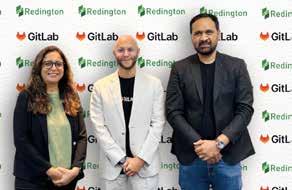
The collaboration further strengthens Redington’s cloud and AI portfolio by delivering a tightly integrated DevSecOps solution that leverages GitLab’s certified integrations optimized for AWS environments as an AWS Advanced Technology Partner with a DevOps ISV Competency. This aligns with Redington’s broader strategy to lead in cloud, data, and AI innovation, while complementing its existing relationships in the AWS ecosystem.
PROVEN Reality will provide organizations with an end-to-end service that will design, build, and operate a customized VR lab for training and education.
PROVEN Reality, a leading Virtual and Augmented Reality company, has announced the launch of a new service to help organizations establish a fully operational Virtual Reality (VR) lab. This service will help organizations set up a place to seamlessly integrate VR into their operations for education, training, and more.
The full-service offering will be an all-inclusive step-by-step solution designed for schools, universities, hospitals, and enterprises looking to adopt VR technologies without the hassle of going through a complex setup process.
“Virtual reality has moved from novelty to necessity,” said Pavel Makarevich, Vice President at PROVEN Solution. “With our VR lab service, PROVEN Reality can help institutions across the GCC take that critical leap—from passive learning and limited training models to immersive, high-impact experiences that improve outcomes and operational efficiency.”
A VR lab can be a dedicated, purpose-built space where everyone can experience immersive simulations using VR technology ideal for:
Universities – Using VR enables a more hands-on learning experience. For example, engineering students can now simulate complex machinery and electrical systems while medical students can safely practice procedures without risk.
Schools – VR transforms traditional classroom learning by making subjects interactive and engaging. The result is deeper engagement, improved comprehension, and stronger knowledge retention.
Enterprises – Businesses can use VR for onboarding, product design, and skill training simulations, such as crisis management and equipment handling, in a risk-free environment. VR can be utilized for real-time collaboration among remote teams and allow product prototyping in shared virtual spaces.

Hospitals – Medical students and professionals can safely practice surgeries and patient care scenarios in lifelike VR environments. Hospitals can also use VR to train staff in emergencies.
The company’s VR solutions are powered by partnerships with global hardware vendors, including HTC, PICO, Apple, and Magic Leap.
Built In-House, MSP Central Enables MSPs To Centralize Service Workflows, Device Control, Threat Protection, and Performance Monitoring in a Single Platform
ManageEngine, a division of Zoho Corporation and a leading provider of enterprise IT management solutions, announced the launch of MSP Central—a unified platform designed to help MSPs streamline service delivery, device management, threat protection, and infrastructure monitoring from a single interface.
ManageEngine focuses on addressing specific operational models and business challenges of MSPs, developing tools that support multi-client environments, technician efficiency, and service scalability. MSP Central brings together these capabilities into a unified platform tailored to how MSPs deliver and manage IT services today.
With the global managed services market projected to reach $511 billion by 2029, MSPs are facing mounting pressure to scale operations without compromising service quality so as to offer a strategic value to customers and differentiate from the competition.
“We had technicians switching between
multiple consoles just to resolve a single client incident—a real drag on time and ticket volume,” said Edgar Martínez, business manager at EvolutionIT, an early adopter of MSP Central. "We were looking for a tool that could bring together everything our team needs without adding complexity or locking us into a rigid stack."
MSP Central directly addresses this fragmentation by offering a unified platform to manage day-to-day operations across clients—from technician workflows and asset visibility to endpoint protection and network health monitoring. Its modular, cloud-native architecture supports native multi-tenancy, fine-grained role-based access control, and seamless integrations with both Zoho apps and third-party tools. This gives MSPs the flexibility to adopt only the modules they need and expand at their own pace.
“With MSP Central, we’re bringing together the best of ManageEngine’s proven IT management and security capabilities in a platform designed from the

ground up for MSPs,” said Mathivanan Venkatachalam, vice president at ManageEngine. “While each of these modules stands strong on its own, together they form a truly unified platform—delivering a single, connected experience for service providers. This approach lets MSPs consolidate their operations, eliminate tool sprawl, and enable their teams to work more efficiently and effectively—all from a unified console."
9% of publicly exposed cloud storage hold sensitive data, 97% classified as restricted or confidential
Tenable, the exposure management company, released its 2025 Cloud Security Risk Report, which revealed that 9% of publicly accessible cloud storage contains sensitive data. Ninety-seven percent of such data is restricted or confidential, creating easy and prime targets for threat actors.
Cloud environments face dramatically increased risk due to exposed sensitive data, misconfigurations, underlying vulnerabilities and poorly stored secrets – such as passwords, API keys and credentials. The 2025 Cloud Security Risk Report provides a deep dive into the most prominent cloud security issues impacting data, identity, workload and AI resources and offers practical mitigation strategies to help organizations proactively reduce risk and close critical gaps.
Key findings include:
• Secrets Found in Diverse Cloud Resources, Putting Organizations at Risk: Over half of organizations (54%) store at least one secret directly in Amazon Web Services (AWS) Elastic Con-
tainer Service (ECS) task definitions — creating a direct attack path. Similar issues were found among organizations using Google Cloud Platform (GCP) Cloud Run (52%) and Microsoft Azure Logic Apps workflows (31%). Alarmingly, 3.5% of all AWS Elastic Compute Cloud (EC2) instances contain secrets in user data — major risk given how widely EC2 is used.
• Cloud Workload Security Is Improving, But Toxic Combinations Persist: While the number of organizations with a “toxic cloud trilogy” – a workload that is a publicly exposed, critically vulnerable, and highly privileged – has decreased from 38% to 29%, this dangerous combination still represents a significant and common risk.
• Using Identity Providers (IdPs) Alone Doesn’t Eliminate Risk: While 83% of AWS organizations are exercising best practices in using IdP services to manage their cloud identities, overly-permissive defaults, excessive entitlements, and standing permissions still expose them to identity-based threats.
GBM will provide AOU with 24x7 threat monitoring, threat hunting, digital forensics, and strategic advisory support
Gulf Business Machines (GBM), a leading end-to-end digital solutions provider, signed an MoU with Arab Open University (AOU) aimed at fortifying cybersecurity resilience, building digital trust, and supporting the sustained evolution of secure digital learning in the region’s education sector.
Headquartered in Kuwait, AOU is a pioneering non-profit institution committed to providing accessible and high-quality blended learning opportunities across the Arab world.
In response to the rising volume and sophistication of cyber threats targeting academic institutions, the agreement sets the foundation for a full-spectrum cybersecurity engagement. The initiative will be powered by GBM’s proprietary COR. platform, delivering a comprehensive suite of Managed
Detection and Response (MDR) services, integration, and cybersecurity consultancy. As part of the engagement, GBM Kuwait (also known as Khorafi Business Machines - KBM) will provide AOU with 24x7 threat monitoring, threat hunting, digital forensics, and strategic advisory support. Leveraging the vendor-agnostic GBM Shield framework and the AI-powered COR. platform, the university will benefit from deep visibility, predictive analytics, and fast response capabilities to reduce risk exposure and increase operational resilience.
Prof. Omar Al-Jarrah, Vice President for Planning and Development and CIO at Arab Open University said, “By partnering with GBM, we are investing in the safety and integrity of our digital infrastructure, empowering our faculty and students with the confidence to teach, learn, and collaborate without disruption. This collabora-

Ari Eitan Director of Cloud Security Research, Tenable
Ari Eitan, Director of Cloud Security Research, Tenable said, “The path for attackers is often simple: exploit public access, steal embedded secrets or abuse overprivileged identities. To close these gaps, security teams need full visibility across their environments and the ability to prioritize and automate remediation before threats escalate.”

tion reinforces our role as a future-ready institution committed to delivering secure, high-quality education across Kuwait and the wider region.”
“Leveraging our deep local expertise and comprehensive cybersecurity solutions, we are proud to support AOU in building a secure, trusted digital learning environment that enables innovation and academic excellence. Our partnership with the university reflects our shared commitment to securing the digital foundation and embedding robust, proactive cybersecurity into the heart of modern education,” said Wassim Seliman, General Manager of GBM Kuwait.
The move aims to accelerate digital transformation across the AECO, manufacturing, and media sectors

Mindware, a leading value-added distributor (VAD) in the Middle East and Africa, has announced an expansion of its relationship with Autodesk, a global leader in software for architects, builders, engineers, designers, manufacturers, 3D artists and production teams. Already an authorized Autodesk distributor in the Levant and RoME (Rest of Middle East) regions,
Mindware will now extend its expertise to the Gulf and Saudi Arabia (KSA), bringing Autodesk’s industry-leading solutions to a wider audience and accelerating digital transformation across the Architecture, Engineering, Construction and Operations (AECO), manufacturing, and media & entertainment sectors.
“This is a natural evolution of our long-standing relationship with Autodesk,” said Philippe Jarre, President, Mindware Group. “Our proven expertise in the Levant region has positioned us as a trusted partner, and we are excited to bring that same commitment to the Gulf and KSA. With Autodesk’s world-class solutions and our extensive channel ecosystem, we are creating unparalleled opportunities for business-
es to thrive in the digital era.”
Mindware will provide a comprehensive suite of value-added services, including partner enablement, technical support, consulting, and go-to-market strategies to drive Autodesk adoption. The partnership will also focus on reseller training, industry-specific workshops, and live demonstrations, ensuring businesses can maximize the benefits of Autodesk’s AI-driven automation, cloud-based collaboration, and data-driven design capabilities.
Globally, Autodesk has been central to delivering the solutions that enable the AECO and manufacturing industry's digital transformation. In the GCC, digital twin technology and smart infrastructure are gaining ground in the AECO sector, as well as in manufacturing, where AI-driven automation is revolutionizing production processes.
"We are thrilled to strengthen our collaboration with Mindware and expand our reach in the GCC,” said Claudette Reuter, Senior Manager, Emerging Markets Channel Sales, at Autodesk. “With Mindware’s regional expertise and strong partner network, we are empowering businesses to embrace innovation, enhance efficiency, and drive sustainable growth.”
Veeam to provide image-based backup support for HPE Morpheus VM Essentials Software

HPE and Veeam Software, announced that the two companies are furthering their long-term, strategic relationship with a new collaboration to offer customers comprehensive data backup and resilience solutions. Veeam Data Platform will integrate with HPE Morpheus VM Essentials Software to give customers a simplified and unified way to protect modern applications and data.
“Data is an organization’s most valuable
asset – and often its most vulnerable,” said Fidelma Russo, executive vice president of hybrid cloud and CTO of HPE. “With our deep partnership and integration, HPE and Veeam are delivering unified virtualization and data protection that is future-ready, giving customers the resiliency and agility to evolve their hybrid IT strategy."
"Organizations face a perfect storm of IT complexity and cyber threats. Data resilience can no longer be an afterthought," said Anand Eswaran, CEO of Veeam. "Our enhanced partnership ensures organizations can deploy enterprise-grade virtualization solutions from HPE with Veeam backup, recovery, security and intelligence for maximum data resilience that keeps
businesses running."
The powerful combination of Veeam Data Platform, HPE Morpheus Software and HPE Zerto Software—backed by increased joint go-to-market investment—enables customer data protection success.
• Veeam to deliver image-based backup for HPE Morpheus VM Essentials Software: Veeam will deliver their industry-leading VM data resilience capabilities to VM Essentials with full fidelity Veeam Data Platform image-based backup support in the near term.
• Comprehensive protection for containerized and cloud-native workloads: In addition to deep Veeam Data Platform integration with VM Essentials and HPE Morpheus Enterprise Software, Veeam Kasten provides leading backup and recovery for containerized and cloud-native workloads. Together, these solutions enable organizations to manage and protect bare metal, virtualized, and containerized workloads.
The VAST AI Operating System, now paired with Cisco UCS and Nexus platforms, and the Hyperfabric AI solution, delivers a unified, zero-trust infrastructure blueprint
VAST Data, the AI Operating System company, announced the expansion of its strategic partnership with Cisco deliver a fully integrated and validated AI infrastructure stack that spans compute, networking, storage, and observability. The VAST AI Operating System is now available directly through Cisco’s Global Price List (GPL) and is fully supported by Cisco as part of the joint solution – simplifying how enterprises implement, operate, and scale modern AI environments by enabling customers to seamlessly procure and deploy VAST AI OS alongside Cisco UCS servers, Nexus switching, and Cisco Nexus Hyperfabric AI.
Together, VAST and Cisco provide a turnkey platform for building enterprise AI Factories – agentic, data-intensive AI systems at scale – ensuring security, perfor-
mance, and operational agility from edge to core to cloud. The joint solution stack enables customers to unify data pipelines, automate infrastructure management, and reason over real-time data using scalable, zero-trust AI infrastructure.
“Cisco and VAST share a vision for making AI infrastructure accessible, secure, and scalable for every enterprise,” said Jeremy Foster, Senior Vice President and General Manager, Cisco Compute. “We’re enabling customers to collapse complexity and unlock faster time-to-value by providing a unified infrastructure stack built for the demands of AI.”
The VAST + Cisco solution is purpose-built for generative and agentic AI workloads, enabling customers to power complex, data-driven applications with the perfor-
The newly launched Digitized Construction Workflows includes centralized tendering and bid management, real-time cost control and scheduling dashboards, Digital twin integration and more

Walid Gomaa CEO, Omnix International
Omnix International, a leading provider of digital transformation and innovative technology solutions, announced the expansion of its portfolio with a new suite of integrated Digitized Construction Workflows offerings. These solutions are de-
signed to digitize critical workflows across the construction lifecycle, fundamentally transforming how projects are planned, executed, and optimized through data intelligence, automation, and intelligent systems.
Tailored to address the unique needs of the Middle East region, this strategic move underscores Omnix’s vision to drive innovation, boost efficiency, and help clients meet evolving demands to build faster, smarter, and more sustainably.
This launch comes at a pivotal time for the construction sector, which faces mounting challenges including labor shortages, cost pressures, regulatory demands, and outdated processes. With the Middle East witnessing rapid urban expansion and executing mega projects, the need for advanced digital solutions has never been greater. According to RICS and McKinsey, the global construction industry continues to lag in digital adoption—especially in areas like ESG reporting, carbon tracking, and lifecycle management. Omnix’s new

Renen Hallak Founder and CEO, VAST
mance, insight, and operational control needed to drive business transformation.
“This partnership represents the convergence of two best-in-class platforms to create a foundational blueprint for enterprise AI,” said Renen Hallak, Founder and CEO at VAST Data. “By aligning the VAST AI OS with Cisco’s UCS and Nexus infrastructure, we’re delivering the turnkey simplicity, observability, and scalability that enterprises need to deploy and manage intelligent systems globally.”
offerings directly address these gaps with integrated tools that promote smarter planning, improved collaboration, and measurable outcomes.
Walid Gomaa, CEO of Omnix International, said, “Our mission to digitally transform construction workflows is aimed at empowering clients to build with greater confidence, efficiency, and purpose. This marks a key milestone in our journey to deliver value-driven, future-ready solutions. Our focus on regional priorities, data interoperability, and intelligent insights will help clients reduce risk, enhance sustainability, and achieve stronger business outcomes across project lifecycles.”
The newly launched Digitized Construction Workflows includes centralized tendering and bid management, real-time cost control and scheduling dashboards, Digital twin integration, Field safety and compliance monitoring, Built-in ESG and carbon analytics, AI-enhanced document and RFI management, and Mobile-enabled tools for site access and task tracking.
At the core of the solution is the company’s “interoperability-first approach” which has a connected layer that allows clients to retain their preferred tools while unlocking enhanced visibility, regional customization and cross-platform data flow.
Enterprise-grade architecture for deploying AI agents across banking and insurance, combines The Universal AI Platform from Dataiku with NVIDIA accelerated computing
Dataiku has announced a new FSI Blueprint for deploying agentic AI systems in financial services. This blueprint is designed to help banking and insurance institutions create, connect, and control intelligent AI agents at scale—with the governance, performance, and flexibility required for production in these highly regulated industries.
This announcement builds on Dataiku’s integration in the NVIDIA Enterprise AI Factory validated design, which helps enterprises accelerate the development and deployment of secure, scalable AI infrastructure.
“AI agents represent the next major shift in enterprise productivity, and banks are among the earliest adopters,” said Malcolm deMayo, Vice President of Global Financial Services at NVIDIA. “This new bank blueprint from Dataiku, accelerated by NVIDIA, combines reusable com-
ponents that enable banks to automate thousands of repetitive manual tasks. This allows institutions to deploy intelligent systems that can adapt to complex workflows and evolve responsibly over time—all while meeting regulatory and compliance requirements through central governance.”
The FSI Blueprint combines The Universal AI Platform and Dataiku LLM Mesh with NVIDIA NIMmicroservices, NVIDIA NeMo, and GPU-accelerated infrastructure. It leverages AI agents powered by NVIDIA to provide financial institutions with a secure and modular foundation for building agentic AI solutions across use cases like fraud detection, customer service, risk analysis, and operations automation.
“Financial institutions are under pressure to operationalize AI faster, while managing risk, regulation, and complexity,”

Renen Hallak Founder and CEO, VAST
said John McCambridge, Global Head of Financial Services at Dataiku. “This FSI Blueprint helps banks and insurers move beyond experimentation, delivering trusted AI agents that are observable, cost-controlled, and designed to deliver meaningful business value.”
New PLS Ultra programme in Local Language, Local Time Zone and Global Standards

Mouteih Chaghlil CEO of MEA, Bespin Global
Bespin Global MEA, a public cloud powerhouse of e& enterprise and a leader in cloud consultancy and managed services, has introduced the Middle East’s first ad-
visory-driven AWS Partner-Led Support (PLS) Ultra programme. The offering combines global AWS support with local, bilingual, GCC engineering teams, providing strategic, region-specific support tailored to the business and technology goals of organisations across the Middle East.
Unlike generic support offerings, Bespin Global MEA’s PLS Ultra is a partner-led, high-touch support programme combining engineering depth with a strategic focus on FinOps, cloud optimisation, and continuous transformation – all adapted to the evolving needs of organisations operating in the Gulf. This model allows Bespin to serve as a single point of contact for support, to accelerate time to resolution and elevate businesses' experiences on AWS for maximum benefit and long-term outcomes.
Mouteih Chaghlil, CEO of Middle East and Africa, Bespin Global, an e& enterprise company said, “Nearly 70% of companies
in the Middle East are planning to migrate the majority of their operations to the cloud by year-end, according to a recent survey amongst UAE and KSA business and technology leaders. In this climate of rapid transformation, agility and innovation are essential to unlocking the full potential of cloud computing – across operational, financial, and customer-facing functions. As technologies like IoT, edge computing, 5G, and AI-powered analytics gain traction, cloud adoption in the GCC will only accelerate.
Bespin Global MEA’s AWS PLS Ultra offering combines deep AWS expertise with local cultural and operational knowledge and acts as a strategic partner. The programme offers direct, enterprise-grade access to advisory resources, removing the need to raise tickets through AWS and accelerating the time to insight, innovation, and optimisation. It includes a tiered support model for Developers, Businesses, and Enterprises - scaling from startups to mission-critical, large-scale cloud operations.
GenAI is expected to improve productivity, efficiency, and automation, with long-term ROI for Public Sector organizations
Nutanix a leader in hybrid multicloud computing, announced the findings of its seventh annual global Public Sector Enterprise Cloud Index (ECI) survey and research report, which measures enterprise progress with cloud adoption in the industry. The research showed that 83% of public sector organizations have a GenAI strategy in place, with 54% actively implementing, and 29% preparing for implementation.
As public sector organizations ramp up GenAI adoption, 76% of IT decision-makers say their current infrastructure needs moderate to significant improvement to support modern, cloud native applications at scale. This year’s public sector ECI found that infrastructure modernization emerged as a top priority, underscoring the growing demand for systems capable of meeting GenAI’s requirements for enterprise-ready data security, data integrity, and resilience.
This year’s report also revealed that public sector leaders are increasingly leveraging GenAI applications/workloads into their organizations. Real-world GenAI use cases across the public sector gravitate towards constituent/employee support and experience solutions (e.g., chatbots) and content generation. However, concerns remain with 92% of public sector leaders highlighting the need for their organizations to do more to secure GenAI models and applications. The results of that need, according to 96% of respondents, is security and privacy becoming higher priorities for their organizations.
“Generative AI is no longer a future concept, it’s already transforming how we work,” said Greg O’Connell, VP, Federal Sales, Public Sector at Nutanix. “94% of public sector organizations are already putting AI to work and expect returns in as little as one year. As public sector leaders look to see outcomes, now is the time to invest in AI-ready infrastructure, data security, privacy, and training to ensure long-term success.”
Public sector survey respondents were asked about GenAI adoptions and trends, Kubernetes and containers, how they’re running business and mission critical applications today, and where they plan to run them in the future. Key findings from this year’s report include:
GenAI solution adoption and deployment in the public sector will necessitate a more comprehensive approach to data security. Public sector respondents indicate a significant amount of work needs to be done to improve the foundational levels of data security/governance required to support GenAI solution implementation and success. 92% of public sector respondents agree that their organization could be doing more to secure its GenAI models and applications. Luckily, many IT decision-makers in the public sector are aware of this impending sea change, with 96% of respondents agreeing that GenAI is changing their orga-
Greg O’Connell VP, Federal Sales, Public Sector, Nutanix

nization’s priorities, with security and privacy becoming higher priorities.
Prioritize infrastructure modernization to support GenAI at scale across public sector organizations. Running modern applications at enterprise scale requires infrastructure solutions that can support the necessary requirements for complex data security, data integrity, and resilience. Unfortunately, 76% of respondents in the public sector believe their current IT infrastructure requires at least moderate improvement to fully support cloud native apps/ containers. Furthermore, IT infrastructure investment was ranked as a top area of improvement among public sector respondents, a sign that IT decision-makers are aware of the need to improve.
GenAI solution adoption in the public sector continues at a rapid pace, but there are still challenges to overcome. When it comes to GenAI adoption, public sector metrics show progress, with 94% of respondents saying their organization is leveraging GenAI applications/workloads today. Most public sector organizations believe GenAI solutions will help improve levels of productivity, automation, and efficiency. However, organizations in the public sector also note a range of challenges and potential hindrances regarding GenAI solution development and deployment, including data security and privacy, and the need for continued upskilling and hiring to support new GenAI projects/solutions.
Application containerization and Kubernetes deployment are expanding across the public sector. Application containerization is increasingly pervasive across industry sectors and is set to expand in adoption across the public sector as well, with 96% of segment respondents saying their organization is at least in the process of containerizing applications. This trend may be driven by the fact that 91% of respondents in the public sector agree their organization benefits from adopting cloud native applications/containers.
Sophos released its sixth annual State of Ransomware report, a vendor-agnostic survey of IT and cybersecurity leaders across 17 countries that studies the impact of ransomware attacks on businesses. This year’s survey found that nearly 50% of companies globally paid the ransom to get their data back – the second highest rate of ransom payment for ransom demands in six years.
While 43% of organizations in the UAE that had data encrypted paid the ransom, 30% of them paid less than the original demand. Globally, in 71% of cases where the companies paid less, they did so through negotiation – either through their own negotiations or with help from a third party. In fact, while the median global ransom demand dropped by a third between 2024 and 2025, the median global ransom payment dropped by 50%, illustrating how companies are becoming more successful at minimizing the impact of ransomware.
Overall, the median ransom payment in the UAE was 1.33 million dollars, although the initial demand varied significantly depending on organization size and revenue. Across the globe, the median ransom demand for companies with over $1 billion in revenue was five million dollars, while organizations with $250 million revenue or less, saw median ransom demands of less than $350,000.
Exploited vulnerabilities were the number one technical root cause of attacks in the UAE, while 49% of ransomware victims said adversaries took advantage of a security gap that they were not aware of – highlighting organizations’ ongoing struggle to see and secure their attack surface. Overall, 54% of UAE organizations said resourcing issues were a factor in them falling victim to the attack, with one third citing a lack of expertise and 30% reporting a shortage of expertise.
Additionally, the report reveals that the impact of ransomware attacks on data in the UAE remains significant. In 55% of the attacks, data was successfully encrypted, surpassing the global average (50%). In 43% of those cases, data was also stolen, much higher than the 28% global rate. Despite this, 98% of affected organizations recovered their data, with 68% using backups and 43% opting to pay the ransom, highlighting both strong recovery strategies and ongoing challenges.
“For many organizations, the chance of being compromised by ransomware actors is just a part of doing business in 2025. The good news is that, thanks to this increased awareness, many companies are arming themselves with resources to limit damage. This includes hiring incident responders who can not only lower ransom payments but also speed up recovery and even stop attacks in progress,” says Chester Wisniewski, director, field CISO, Sophos.

Chester Wisniewski Director, Field CISO, Sophos
“Of course, ransomware can still be ‘cured’ by tackling the root causes of attacks: exploited vulnerabilities, lack of visibility into the attack surface, and too few resources. We’re seeing more companies recognize they need help and moving to Managed Detection and Response (MDR) services for defense. MDR coupled with proactive security strategies, such as multifactor authentication and patching, can go a long way in preventing ransomware from the start.”
Additional Key UAE Findings from the State of Ransomware 2025 Report:
• Exploited vulnerabilities were the most common technical root cause of attack, used in 42% of attacks. They are followed by malicious emails, which were the start of 23% of attacks. Compromised credentials were used in 18% of attacks
• Business impact of ransomware
» Excluding any ransom payments, the average (mean) bill incurred by organizations in the UAE to recover from a ransomware attack in the last year came in at $1.41 million, below the $1.53 million global average. This includes costs of downtime, people time, device cost, network cost, lost opportunity, etc.
» Organizations in the UAE recovered swiftly from ransomware attacks, with 63% fully recovered up to a week, notably above the 53% global average. 15% took between one and six months to recover, below the 18% global average.
By embracing advanced technologies and best practices, organizations can safeguard their critical data, minimize downtime, and remain resilient in the face of unexpected disruptions.
Few cyber threats provoke as much concern or cause as much disruption and resource drain as ransomware. Ransomware has today evolved into a global, organized criminal enterprise. Ransomware-as-a-Service (RaaS), a business model is at the heart of this transformation and has reshaped cybercrime by dramatically lowering the barrier to entry.
The rise of generative AI has also enhanced the potency of ransomware by enabling faster, smarter, and more convincing attack tactics. The modern ransomware ecosystem in fact mirrors the
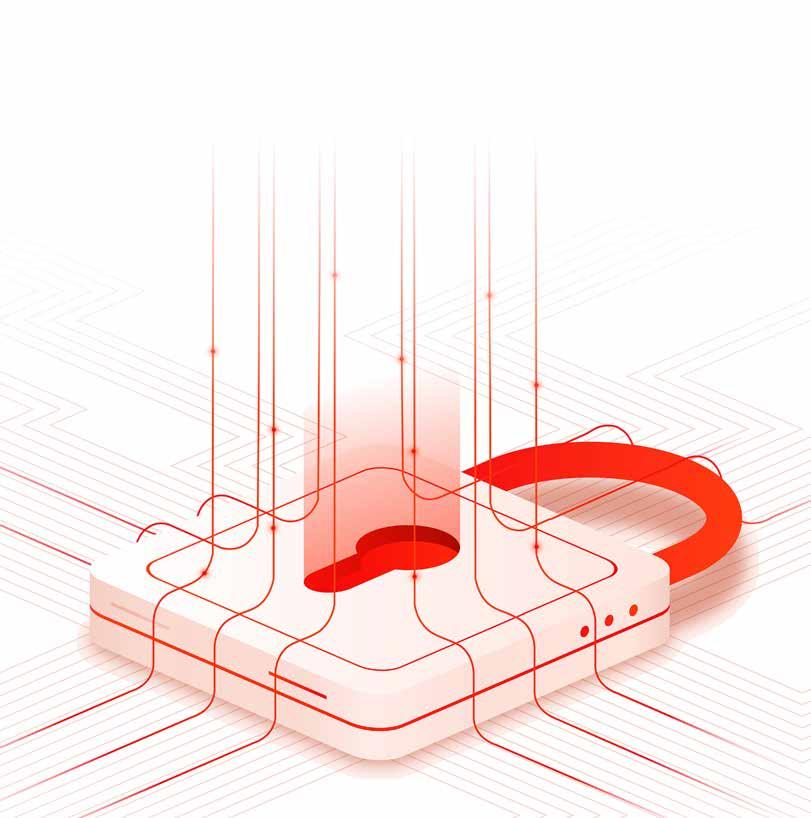
agility of tech startups, complete with product-as-a-service models, customer support, performance dashboards, and profit-sharing programs. The consequences for enterprises are measured not only in millions lost but in trust eroded and continuity shattered.
The ransomware threat has moved from the shadows into the center stage of enterprise risk. Unlike the past, when attacks were few and technically complex, today’s threat actors can simply

Binesh Balan Head of Information Security, Gulftainer
subscribe to a ready-made toolkit, target organizations worldwide, and launch devastating attacks—often without writing a single line of code.
“Forget lone wolf hackers in dark basements. The biggest shift we’ve seen is the rise of Ransomware-as-a-Service (RaaS),” says Binesh Balan, Head of Information Security at Gulftainer. “This is a slick, subscription-based business model where criminal developers create and maintain the ransomware, then lease it out to less-skilled affiliates. This model now dominates the threat landscape, lowering the bar for entry and causing a massive spike in attack volume.”
RaaS offers not just the malware but access to dashboards, customization tools, even negotiation bots. Just like SaaS businesses, RaaS operators offer “support” to their affiliates, handle ransom negotiations, and often take a cut of the payout—estimated between 20–40%. According to multiple threat intelligence reports, groups like RansomHub, Qilin, and BlackCat are among the most prolific RaaS operators, responsible for a significant percentage of global ransomware activity in 2024.
From a regional point of view, the region continues to see a surge of ransomware threats.
“From a regional perspective, we are in the crosshairs,” Balan continues. “According to the UAE Cyber Security Council, ransomware attacks in the UAE surged by 32% in 2024 compared to the previous year. This rapid digitalization, economic growth, and high-value data make organizations in sectors like finance, energy, and government prime targets.”
“The RaaS model means an attacker anywhere can easily target a business in UAE with devastating effect,” he warns. “Anyone can become a digital extortionist with RaaS subscription and access
to a crypto wallet—but the most insidious threat might already be inside your network.”
Waqar Anjum, CISO at Shuaa Capital, underscores the franchise-like nature of modern cybercrime.
He says, “Ransomware-as-a-Service has lowered the barrier for entry into cybercrime. Attackers no longer need advanced coding skills; they can simply rent ransomware kits and share profits with the developers. This ‘franchise model’ has led to an explosion of attacks globally and has also impacted our region, particularly sectors undergoing rapid digital transformation like finance, energy, and government services.”
Generative AI can be viewed as a force multiplier that has supercharged ransomware operations.
“Now, we have Gen AI thrown into the mix. This isn't science fiction; it's happening now,” says Binesh. “While still an emerging threat, generative AI is being used to craft hyper-realistic phishing emails with fewer errors, create polymorphic malware that constantly changes to evade detection, and automate attacks.”
One of the most staggering statistics comes from a 2024 analysis of phishing campaigns. Since the popularization of Gen AI tools like ChatGPT, phishing incidents have surged by over 4,100%, largely because these tools make it easy to generate polished, grammatically accurate, and context-aware lures in seconds.
“The speed and precision we are witnessing now is unlike anything before,” notes Waqar. “AI helps attackers draft highly personalized phishing campaigns, discover vulnerabilities faster, and even automate negotiations with victims. Threat actors can adapt in days, not months which makes it a continuous battle.”
Anoop Kumar, Head of Information Security GRC at Al Nisr Publishing, puts it into sharp perspective when he says, “Ransomware-as-a-Service is no longer a fleeting threat; it is a thriving global industry. With the integration of Generative AI, ransomware is faster, stealthier, and far more personalized than ever before. From polished phishing attacks to deepfake impersonations, the cybercriminals of today behave more like agile startups than rogue individuals.”
He adds, “To defend against this new generation of threats, both cybersecurity posture and policy must evolve. It requires not just technology, but collaboration, regulation, and above all, a deep understanding that in the AI era, identity is the new battlefield, and trust must be continuously earned.”
As ransomware evolves, the defense must do more than keep pace. It must anticipate, adapt, and recover swiftly. Traditional perimeter-based security models are insufficient when data, users, and devices are everywhere.
“The old model of building a fortress with a perimeter firewall is obsolete,” says Binesh. “Security must be a layer that travels with the device, protecting your assets no matter the location.”Here’s

the revised version with the first two points rewritten as descriptive paragraphs:
He outlines a multi-pronged ransomware defense strategy built on four foundational pillars.
Intelligent Prevention begins with eliminating the most common entry points that ransomware actors exploit—typically email and web-based vectors. Balan emphasizes the importance of deploying AI-driven Integrated Cloud Email Security (ICES) to automatically detect and neutralize phishing attempts. He adds that empowering users through automated response mechanisms can transform the entire workforce into a frontline defense. To complement this, organizations should implement Secure Web Gateways (SWG), Cloud Access Security Brokers (CASB), and Remote Browser Isolation (RBI) to neutralize threats encountered during everyday browsing.
Rapid Detection & Response is built on the assumption that no environment is impenetrable. “Assume breach,” Balan advises, stressing the need to reduce attacker dwell time from days to minutes. This requires deploying a combination of Endpoint Detection and Response (EDR), Extended Detection and Response (XDR), and Managed Detection and Response (MDR) solutions. When paired with SOAR (Security Orchestration, Automation, and Response), these tools enable real-time alerting and automated containment actions—transforming detection into decisive, instant response.
Decisive Containment involves tactical steps to stop ransomware from spreading laterally across the network. Balan recommends enforcing strict firewall policies to block commonly abused protocols like SMB and RDP, disabling PowerShell where not essential, and using solutions like Local Administrator Password
Solution (LAPS) to secure privileged credentials. These actions are designed to cut off the attacker’s ability to escalate and move within the environment.
Finally, Resilient Recovery is the last and most critical pillar. “This hinges on one thing—immutable, offline backups,” says Balan. He stresses that only with securely isolated backups can an organization avoid paying ransom and ensure business continuity. Post-incident, conducting thorough forensic analysis is essential to identify the root cause, close security gaps, and prevent repeat attacks.
Anoop adds a philosophical perspective.
“Cybersecurity is no longer just about defense. It’s about resilience. Ransomware is no longer a surprise, but an inevitability. A resilient ransomware defense strategy is not a static checklist— it’s a living, breathing capability.”
“By investing in layered defenses, training your people, and embracing adaptive security frameworks, you can position your organization not just to survive ransomware—but to emerge stronger from every attempt.”
Zero Trust Architecture (ZTA) is not a buzzword—it’s fast becoming a cornerstone of modern cyber defense.
“Zero Trust is a security model built on the principle of ‘never trust, always verify,’” explains Binesh. “It assumes no user or device is trusted by default, even if they are inside the network. Is it a realistic and effective defense? The data says yes. According to IBM’s 2024 report, organizations with a mature Zero Trust architecture experienced breach costs $1.76 million lower than those without.”
Anoop adds an analogy to highlight the relevance of Zero Trust. “Zero Trust doesn’t prevent ransomware from knocking, but it ensures the doors stay locked, the rooms are isolated, and the alarms are always on.”
He cautions, however, that ZTA is a strategic, long-term commitment—not a plug-and-play solution.
Technology may fail, but awareness can catch what machines miss. Despite billions spent on cybersecurity tools, phishing remains the #1 delivery mechanism for ransomware.
“Employee awareness is extremely critical. Insider threat is the most significant which in most cases is overlooked and results in catastrophe,” warns Waqar. “Most ransomware attacks still start with a phishing email. No technology can fully prevent a user from clicking a malicious link or enabling a macro.”
“Awareness training must be continuous and engaging. Short modules, phishing simulations, and real-world examples work better than yearly seminars. At my organization, regular simulations have reduced risky behavior significantly and fostered a culture where cybersecurity is everyone’s responsibility.”
Anoop Kumar Head of Information Security GRC, Al Nisr Publishing

As ransomware damages skyrocket, cyber insurance has become a financial safety net. But it’s not a cure-all.
“Cyber insurance has become a safety net, covering ransom payments, legal costs, and recovery expenses,” says Anjum. “However, premiums and requirements have become stricter. Insurers now demand evidence of robust controls—MFA, EDR, patch management—before offering coverage or fair pricing.”
He adds, “Insurance is not a substitute for security. It covers the financial aspect but not the reputational damage. Another concern is moral hazard. Attackers know companies have insurance and may target them expecting a payout.”
An incident response plan needs to be tested to ensure it will be effective in realistic conditions.
“Simulation exercises are where theory meets reality,” says Waqar. “A well-written incident response plan is useless if no one has practiced it.”
“We conduct both tabletop exercises (to align leadership and decision-making) and technical drills (to test IT and InfoSec teams). These drills reveal gaps—be it in communication, recovery speed, or vendor coordination—and allow us to fix them before a real incident.”
Security budgets are limited and therefore striking the right in-
vestment balance between proactive controls and recovery readiness is strategic—not optional.
“Striking the right balance between proactive security controls and recovery/continuity planning is one of the most strategic decisions an organization can make,” says Anoop.
“Prevention will reduce the number and severity of attacks. Recovery will ensure that, even in the worst-case scenario, your business survives and thrives. Together, they form a complete, adaptive strategy that reflects the reality of today’s threat landscape.”
“The glow of the screen, the sudden lock-out, the chilling demand for payment—it’s a modern-day horror story playing out in boardrooms and server rooms across the globe,” says Binesh. “The perpetrators are getting smarter, faster, and more organized every day.”
Ransomware is no longer a fringe threat. In the Gen AI era, where phishing is automated and malware evolves in real-time, traditional defenses crumble under pressure. The solution is not fear, but to build foresight and resilience.
Intelligent defenses, well-trained employees, clear recovery protocols, and continuous adaptation are a mist. Ransomware has transformed but so too must enterprise defense.
“Cybersecurity is no longer just about defense. It’s about resilience. Ransomware is no longer a surprise, but an inevitability. A resilient ransomware defense strategy is not a static checklist—it’s a living, breathing capability.”
As Ermetix expands its footprint into the Middle East, Diego Fasano, CEO of Ermetix outlines the company’s strategy, use of AI, vertical focus, and long-term regional commitment.

Diego Fasano CEO, Ermetix
What sets Ermetix apart in the cybersecurity landscape?
Ermetix is the only cybersecurity company globally that combines Unified Endpoint Management (UEM) with Mobile Threat Defense (MTD) into a single platform. Traditionally, these are separate product categories—UEM tools manage devices, while MTD tools secure them. Our unique platform integrates both, giving users a single dashboard, one license, one training path, and significantly reduced total cost of ownership. That’s our biggest differentiator.
Would you say your strength lies more in MTD than UEM?
Absolutely. Our DNA is in mobile security. Many of our team members, including myself, come from an offensive cybersecurity background; we were formerly part of government red teams. That gives us deep insight into how attackers think and operate. We use that knowledge to build proactive defenses. Our MTD capabilities are built with that mindset, especially for iOS and Android.
What’s the benefit of combining UEM and MTD in one solution? The advantage is both technical and economic. End users no longer need to juggle multiple vendors, dashboards, or licenses. With Ermetix, there’s no integration cost and lower complexity. From a cost standpoint, instead of paying for two or three separate products, customers get everything under a single license. That’s a major gain in total cost of ownership and operational efficiency.
How are you positioning Ermetix against traditional UEM players?
Our challenge to traditional UEM vendors is strategic. We’re helping customers understand that UEM isn’t just an IT operations function—it’s a critical pillar of cybersecurity. Unmanaged devices are insecure devices. So our job is to evangelize the idea that managing endpoints is the first step in securing them. It’s not a separate discussion.
How do you view the opportunity in the Middle East?
The Middle East is an incredible opportunity. I often say, “The future is starting here.” The region is undergoing a massive digital transformation. Also, in today’s geopolitical environment, many enterprises and governments are looking for European cybersecurity alternatives, especially ones that aren’t tied to the U.S., Israel, or Russia. As an EU-based company with 100% Italian technology, we offer a different ethical and regulatory profile, and that matters to customers in this region.
With all this talk about security, how do you ensure a seamless user experience?
That’s a key part of our product strategy. Many cybersecurity
vendors build tools from an engineering-first mindset. We started by focusing on what the end user needs. We ran focus groups to design our dashboard UX and built the product around simplicity. But user experience is also cultural. We tell our customers: it’s not just about having the right tools—you need a cybersecurity mindset. We call it “cyber mentality.” Tools help, but awareness and behavior are what make security work.
How is Ermetix leveraging AI in your platform?
We’ve been using AI since before it became a buzzword. In fact, attackers have been using AI to automate and enhance attacks for at least two or three years. At Ermetix, we use AI in our IOC (Indicator of Compromise) correlation engine, which is one of the three layers of protection in our mobile defense stack. This engine can detect advanced malware including government spyware, even if it hasn’t been seen before. That’s because our AI engine looks at behavior and patterns, not just signatures. We also have a dedicated AI R&D team focused solely on advancing this capability.
Are there specific verticals where your solution is gaining traction?
Yes. We started out in education, particularly in schools that use tablets extensively. At the same time, we built traction in military environments. Today, our top three verticals are Healthcare, Education as well as Government and Law Enforcement. Hospitals use Ermetix to secure mobile devices that handle EMRs. In transportation, for example, Rome’s municipal transport system uses our platform to manage and secure ticketing devices. In Government and law enforcement, especially with the possibility of mobile-targeted attacks, interest in mobile defense has grown.
How easy is it for Ermetix to integrate with other cybersecurity solutions and environments?
Our solution is cloud-native, with a multi-instance architecture that runs seamlessly across AWS, Azure, GCP, and private clouds. We also designed the platform to natively integrate with third-party tools like SIEM and observability platforms, which typically lack mobile visibility. So we fill that gap and enable complete mobile observability and control across environments.
With the shift to hybrid work, what advice would you give on mobile device management strategy?
We urge organizations to stop thinking in terms of devices and start thinking in terms of operating systems. Android, for instance, isn’t just on smartphones—it’s on tablets, IFPs, kiosks, and even thermostats. Our advice: secure every instance of the OS, not just the form factor. That’s the shift we promote—OS-centric cybersecurity.
What are your plans for the Middle East going forward?
We’re fully committed to the region. We’ve already opened a local entity and hired employees here. This isn’t a short-term sales campaign—it’s a long-term presence strategy. We’re working closely with our partners and have a pipeline of regional alliances. We’re here to stay, not just to sell.
What does your global footprint look like?
Italy is our home market, and we’re one of the top two vendors there in our space. We also have operations in France, Germany, the UK, Poland, and we’ve recently expanded into South America, particularly in education. We’re now preparing to enter India, where we’ve signed with a distributor and are planning a launch. Growth is strong, but we’re managing it carefully to maintain quality and execution.
"Many of these vendors focus on narrow OT visibility or network monitoring. At Positive Technologies, that's just a small piece of our portfolio. We offer end-to-end capabilities: vulnerability management, endpoint protection, sandboxing, application security, incident response, and much more."
Ray Kafity, Vice President of Middle East, Turkey & Africa, Halcyon outlines the company’s distinct prevention-first strategy, its upcoming expansion into Saudi Arabia, and how agentic AI could redefine the global ransomware defense landscape.
What is the company’s core focus within cybersecurity?
The company is dedicated to one mission — preventing ransomware. Everything we do centers around stopping ransomware attacks and mitigating their business impact.
Our solution is designed to prevent and protect against ransomware and also help recover encrypted files. Ransomware typically encrypts critical files or exfiltrates data, demanding a ransom for access. Our platform defends against both vectors.
Is it a SaaS-based platform? What components does it include?
It's a hybrid model. Part of our solution includes an endpoint agent, while the management console is hosted on AWS as a SaaS offering.
When was the company launched, and when did you enter the Middle East market?
We’re a US-based company founded in 2021. Our Middle East, Turkey, and Africa (META) operations began in May 2024, so we’ve been active in the region for just over a year now. We currently have 12 active customers and a strong pipeline valued at $10 million USD.
How does your solution differ from conventional ransomware protection models?
Traditional ransomware solutions are often reactive and can be bypassed. We took a fundamentally different approach—building a platform infused with AI to detect and respond to ransomware in real time. It’s designed with a deep understanding of the evolving tools, tactics, and procedures used by ransomware and Ransomware-as-a-Service (RaaS) groups. Our threat intelligence constantly feeds back into the platform to keep it adaptive.
Do you currently leverage agentic AI in your platform?
Not yet, but it’s in development. Agentic AI will allow AI agents to interact autonomously across distributed environments, sharing intelligence and responding faster. Once live, this will elevate our platform’s ability to defend against globally coordinated threats.
What’s your go-to-market strategy in the region?
We follow a two-tier distribution model. Our distributor is Spire, and under them, we work with around two dozen partners, including value-added resellers and systems integrators who help us deliver our solutions across the region.
Would you describe your platform as a point solution or part of a broader SOC framework?
It can be both. It functions effectively as a standalone point product, but it also fits within a Managed Security Service Provider (MSSP) model in a SOC environment. We’re in discussions with several regional ISPs who are exploring our Ransomware-as-a-Service offering.
With the trend toward unified security platforms, how do you position your solution?
Consolidated platforms can be valuable, but they also carry risk. If

Ray Kafity Vice President of META, Halcyon
a vendor like Fortinet, for example, misses a threat and blames it on a missing module, that consolidation loses its value. We believe specialized, intelligent solutions — like ours — play a critical role in a layered security architecture.
What’s the average impact of a ransomware attack in the Middle East and Africa?
According to research, the average cost to remediate a ransomware attack in the Middle East and Africa is around $8–9 million USD per incident. For a fraction of that — a few hundred thousand dollars — our platform can prevent such costly damage, making it a sound return on investment.
What did you showcase at GISEC this year?
This year, we’ve announced two key enhancements:
1. A Data Exfiltration Protection Module to block double, triple, and even quadruple extortion attacks where ransomware groups steal data and threaten to leak it.
2. A new Ransomware Detection and Response (RDR) Team that provides 24/7 threat triage, analysis, and alert response — included with our platform at no additional cost.
Discuss any regional expansion plans?
Saudi Arabia is our next strategic focus. We're establishing a local office there and hiring a full team to serve the Kingdom's growing cybersecurity needs.
What’s your current team size in the region?
We’re a lean team of five at the moment — two technical experts and three sales professionals, with plans to scale as we expand further.
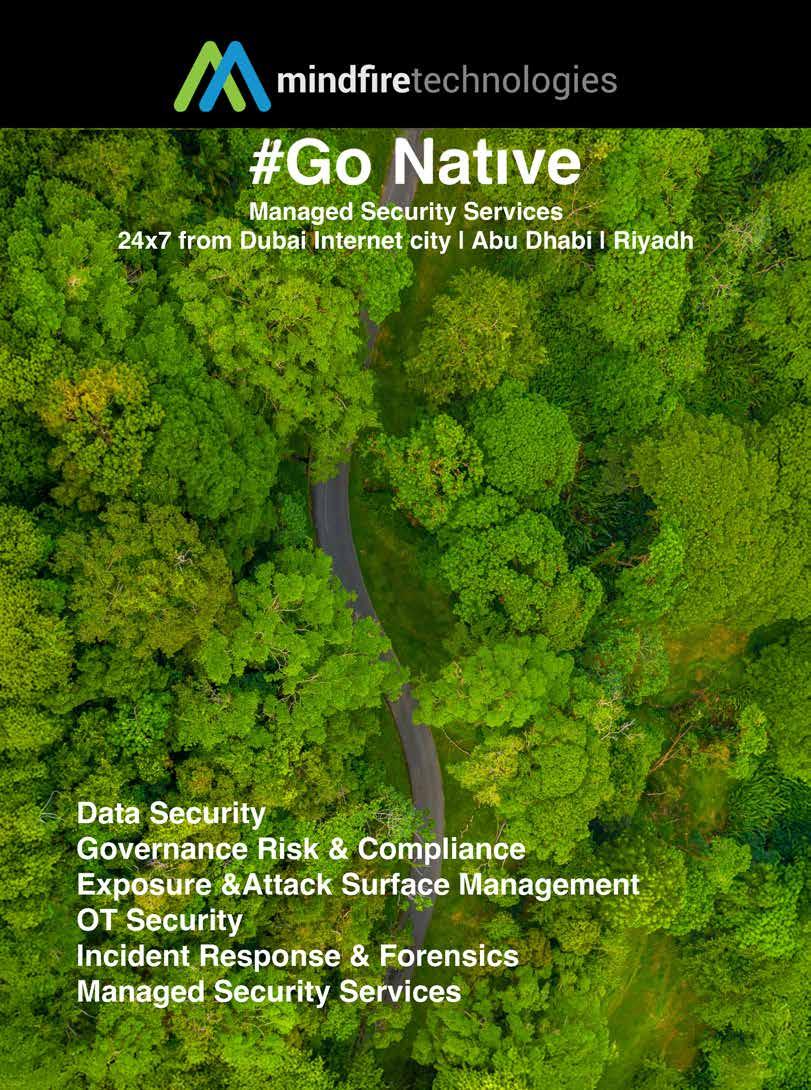
With two decades of experience securing critical infrastructure across Russia, Positive Technologies is expanding its footprint in the Middle East. In this conversation, Ilya Leonov, Regional Director for Positive Technologies in the UAE and Middle East highlights its dual strength in OT and IT cybersecurity, its mature APT detection capabilities, and its long-term regional strategy.
Tell us about Positive Technologies’ focus and growth strategy in the Middle East.
Our operations in the region are expanding steadily. While we operate across multiple territories and focus areas, our core strength lies in two main domains: offensive and defensive cybersecurity services and our product portfolio. We’ve built deep expertise over the last 20 years, particularly in areas like application security, industrial security, and network protection. These capabilities allow us to bring substantial value to clients, especially those in critical infrastructure sectors.
Critical infrastructure protection is a big theme. What are the challenges customers face, and how do you help address them?
Protecting critical national assets is something we have vast experience in. In Russia, for instance, we protect 80% of critical infrastructure—covering oil and gas, nuclear, hydropower, transportation, and more. The fact that there’s been no reported collapse or compromise of Russia’s infrastructure is a testament to our effectiveness.
In the Middle East, we see a clear opportunity to replicate that success. The OT space is complex and underserved, often due to legacy systems, the sensitive nature of SCADA/PLC environments, and the high stakes involved. Our value goes beyond tools—we provide expertise, education, and proven processes for building effective OT cybersecurity programs.
How do you split your business between IT and OT security?
While it’s hard to assign exact percentages, I’d estimate that OT security makes up around 30% of our overall business— and it's growing. In the Middle East, we are in the early stages, but we’re committed to the long game. Success here requires deep expertise, long-term investment, and patience. Globally, IT still dominates the addressable market, but the trend is clearly shifting. OT has been neglected for years, but with rising digitalization and attack surfaces, we believe the next 5 to 10 years will see OT security become a major focus area.

Ilya Leonov Regional Director, Positive Technologies
Can you share any success stories or complex deployments you've handled?
Every OT deployment is a challenge. Take the transport infrastructure in Russia, for example—we operate across 11 time zones and an incredibly complex mix of legacy and modern systems. Building comprehensive monitoring and response across such an environment is no small feat. And it's not plugand-play like IT. SCADA and PLC systems require deep cus-
tomization and care. The same goes for oil and gas, power generation, and nuclear environments. We’ve repeatedly succeeded in building these systems from the ground up.
How do you position Positive Technologies in comparison to other OT-focused vendors like Nozomi or OPSWAT?
Many of these vendors focus on narrow OT visibility or network monitoring. At Positive Technologies, that's just a small piece of our portfolio. We offer end-to-end capabilities: vulnerability management, endpoint protection, sandboxing, application security, incident response, and much more. For us, OT visibility is one module—not the full offering. We don’t consider ourselves in direct competition because our approach is much broader and more holistic.
How would you describe your overall identity as a cybersecurity company?
We're an expert-driven company, highly technical and very practical. Until recently, we didn’t focus much on marketing— our reputation grew through word of mouth and strong results. But now we recognize the need for visibility, especially in new regions like the Middle East. Our customers often tell us, “I never imagined these vulnerabilities existed in my infrastructure—until we worked with you.” That’s the kind of feedback that validates our approach.
Discuss the threat from APT (Advanced Persistent Threats ) attacks and your solutions for detecting and neutralizing APTs.
APT groups pose the most serious cybersecurity threat in the region due to their substantial funding and advanced technical capabilities. In 2024, they were responsible for 32% of all documented cyberattacks, primarily targeting government bodies and critical infrastructure. These incidents often transcended typical cybercrime, involving cyberespionage and even acts of cyberwarfare. Their objectives extended beyond data theft — aiming to erode public trust in government institutions and assert dominance in the digital landscape.
We’ve developed one of the most mature anti-APT solutions in the industry. With over 20 years of R&D, we’ve built proprietary content and detection methods that help identify sophisticated intrusions—often state-sponsored. Our solutions can uncover long-dwelling backdoors and stealthy hacker presence, sometimes persisting for five years or more inside networks.
We’ve identified North Korean groups and other well-resourced threat actors by detecting patterns others miss. That’s
where our maturity and deep research give us a distinct edge.
How has GISEC been for you this year?
This was our third year at GISEC, and it’s always a highlight for us. What we love about GISEC is that it attracts practical, hands-on cybersecurity professionals, not just executives. We showcased live demos like cold-boot injection attacks and BitLocker bypasses, and ran workshops in our Hacker Sphere zone. These events help us engage deeply with the community, and we’ll definitely continue participating in future editions.
“The OT space is complex and underserved, often due to legacy systems, the sensitive nature of SCADA/PLC environments, and the high stakes involved. Our value goes beyond tools— we provide expertise, education, and proven processes for building effective OT cybersecurity programs.”
Ahmad Ghandour, Regional VP - Middle East at Backbase discusses the recently launched Backbase AI-powered banking platform

Ahmad Ghandour Regional VP - Middle East, Backbase
Your announcement claims that this is the world’s first AI-powered banking platform. What makes it fundamentally different from other AI-enhanced banking offerings?
Most AI initiatives in banking today are just that—initiatives. Isolated features bolted onto outdated systems, usually limited to specific channels or use cases. Backbase is fundamentally different: we’ve reimagined the entire banking experience from the ground up, with intelligence at its core.
Backbase is delivering the first unified banking platform that em-
beds AI natively into customer servicing and digital sales—two pillars traditionally managed in silos. We’re fusing them into one intelligent suite that can accelerate growth and efficiency at scale. It’s powered by three key components:
• Intelligence Fabric: A unified data layer that turns every customer interaction and transaction into actionable intelligence.
• Agentic AI: Modular, explainable AI agents that automate, personalize, and optimize every journey-front to back.
• AI Factory: Our hands-on delivery model that embeds AI talent directly into banks, bridging the skills gap and accelerating real-world adoption.
• No other solution orchestrates data, automation, and engagement across the entire banking lifecycle like this. That’s why we believe this is the world’s first truly AI-powered banking platform.
You’ve talked about this representing the ‘democratization of AI’ which I think draws parallel to how SaaS democratized enterprise software. What does this mean for enterprises?
With SaaS, software became accessible to companies of all sizes. Now we’re entering a similar era with AI—where intelligent banking experiences are no longer exclusive to large, tech-savvy institutions. Our platform is designed to democratize AI in the same way SaaS democratized software.
There’s no need to build from scratch anymore. We’ve built the infrastructure—data foundation, agentic automation, and expert support—so banks of any size can plug in and start orchestrating intelligent, high-impact banking experiences from day one. The Intelligence Fabric connects the dots across fragmented data, while the AI Factory brings our experts directly into bank teams. AI is no longer an R&D project—it’s an operational reality, available to every bank ready to embrace it.
Let’s talk safeguards. What controls are in place to prevent biased or discriminatory AI outcomes, especially in highstakes areas like credit?
Responsible AI is non-negotiable in financial services. From the ground up, we’ve designed the platform to ensure every decision, recommendation, and action is transparent, secure, and auditable.
We use a multi-layered approach to safeguard:
• Rigorous model evaluation and bias mitigation before deployment.
• Continuous monitoring to detect and address any emerging bias or drift.
• Embedded policy enforcement so banks can set and adjust controls in line with regulatory and ethical standards.
Our Agentic AI operates within bank-grade control and observability parameters, so institutions retain full oversight of their AI systems. Specifically for credit decisions, explainability is built in. We provide human-readable rationales that map directly to the criteria used, so banks can justify and audit decisions with full transparency.
You mentioned banks maintain control over the AI’s decision-making processes. What does that control actually look like in practice?
It looks like real governance. Banks can define their own guardrails, escalation paths, and approval workflows. Our platform includes explainable AI, policy enforcement, and observability baked in. Through our secure architecture, every agent action can be traced, understood, and configured to fit a bank’s compliance framework.
It’s a tightly controlled environment, not a black box. It’s a transparent, auditable system where banks define the rules, monitor outcomes, and retain ultimate accountability. As a result, banks are able to scale with confidence while meeting the highest standards for risk, compliance, and operational integrity.
A core differentiator seems to be your use of Agentic AI. What does agent-based automation actually look like in a real-world banking scenario?
Agentic AI transforms how banks operate by deploying modular, autonomous agents that act as intelligent teammates. Unlike static bots or single-purpose tools, these agents adapt to context, learn from interactions, and execute tasks end-to-end-while staying within guardrails.
For example, one agent might orchestrate customer onboarding, another could run personalised upsell campaigns, and yet another might manage end-to-end transaction disputes. These agents operate across four dimensions: autonomous task execution, context-aware adaptation, seamless integration with existing systems, and full auditability.
Think of them as intelligent co-workers handling repetitive and complex tasks alike—freeing up human teams to focus on relationship-building and strategic work.
What kind of measurable impact are you seeing in terms of cost savings, revenue growth, or productivity gains?
We’re seeing impact across all three fronts—growth, efficiency, and experience. Our Intelligence Fabric alone can boost operational productivity by around 33%. In terms of growth, banks pairing AI with frontline staff are seeing up to 600 basis points of additional revenue.
On the cost side, the potential is huge: $900 million in savings by 2028 is within reach for banks who adopt AI strategically. In
fact, 36% of financial services professionals already report that AI applications have helped cut annual costs by over 10%. Across the board, we estimate that up to $340 billion in value could be unlocked if GenAI use cases are fully implemented.
Finally, where does Backbase go from here? And what does this mean for the industry more broadly?
For Backbase, this is the foundation of a much larger transformation. We’ve built a platform that can scale with the ambitions of our customers—whether that’s a regional bank looking to boost productivity or a global institution rearchitecting its entire operating model.
For the industry, it signals the start of a new competitive era. AI is no longer a future consideration—it’s today’s growth engine. Banks that embrace AI-powered platforms will pull ahead. Those that remain tethered to legacy systems will find it increasingly difficult to compete on cost, experience, or speed.
Simply put, we believe the next leaders in banking will be those who treat AI not as a feature, but as the foundation.
"Responsible AI is non-negotiable in financial services. From the ground up, we’ve designed the platform to ensure every decision, recommendation, and action is transparent, secure, and auditable."
Antoinette Hodes, Global Solutions Architect & Evangelist, Office of the CTO, Check Point Software Technologies discusses the challenges to fully securing autonomous Industrial Systems
In the rapidly evolving world of industrial IoT (IIoT), the integration of AI-driven decision-making into operational technology (OT) systems has created the impression of tighter control, smarter response times and predictive efficiency. This feeling of having control might actually be a risky illusion.
Autonomous systems are now responsible for critical infrastructure: smart grids, manufacturing lines and water treatment facilities, all relying on interconnected sensors and AI for autonomous decision-making. But as the layers of automation deepen, so too does the complexity, making it increasingly difficult to understand or audit decisions made by machines.
As more layers of automation are added, the number of interconnected components - think of sensors, AI algorithms, communication network, and control systems- grows exponentially. Each new layer introduces more variables, dependencies and potential points of failure. AI models themselves often operate as “black boxes,” making decisions based on patterns and data that are not always transparent. Plus, these systems constantly adapt and learn in real time, which adds unpredictability. All of this combined makes it harder to fully grasp, track, or audit how decisions are made inside the system, driving complexity ever higher.
The role of AI in OT environments
AI is transforming OT environments by enabling real-time analytics, predictive maintenance, dynamic response mechanisms and system-wide orchestration. Here are key examples of how AI is applied:
• Predictive maintenance: In manufacturing, AI models forecast machinery failures based on metrics like vibration analysis and thermal imaging, reducing downtime.
• Anomaly detection: In the energy sector, AI monitors voltage and frequency to detect abnormalities in grid performance before outages occur.
• Autonomous control systems: In water treatment, AI algorithms dynamically adjust chemical dosages and valve operations based on sensor data.
These implementations are part of Industry 4.0, where cyber-physical systems not only automate processes and boost efficiency but also blur the lines between IT and OT. Traditionally, OT systems were isolated, air-gapped and closed off from external networks for security. Now, with the rise of smart sensors, cloud computing and (smart edge) connected devices, those boundaries are blurring. IT and OT are becoming deeply intertwined, creating new opportunities, but also new risks, as the systems become more interconnected and dependent on each other.
Examples of automation per OT vertical

Antoinette Hodes
Global Solutions Architect & Evangelist, Office of the CTO, Check Point Software
• Energy: AI predicts load demand, optimizes energy dispatch and autonomously reroutes power in case of faults. Enel in Italy, uses AI and smart grids to balance energy supply and demand dynamically.
• Manufacturing: Smart robots handle QA with computer vision, reorder inventory autonomously and self-correct production inefficiencies. Bosch uses smart robots equipped with computer vision for quality assurance on their production lines, spotting defects in real time.
• Critical Infrastructure: AI regulates traffic lights based on congestion data and operates dam sluice gates to balance water levels. The Oosterschelde Keering is part of the Netherlands’ famous Delta Works, a massive system of dams, sluices, locks and barriers designed to protect the lower laying country from flooding by the North Sea. The barrier’s sluice gates can be autonomously operated to regulate water flow and maintain safe
water levels, balancing the need to protect against storm surges while allowing tidal movements and shipping traffic. Sensors continuously monitor sea levels, weather conditions and structural integrity, feeding data into advanced control algorithms that decide when to close or open the gates.
The paradox of autonomy lies in the delicate balance between human control and machine independence. Autonomous systems are designed to operate without constant human intervention, aiming to enhance efficiency and responsiveness. However, this shift places human operators on the sidelines, reducing their direct oversight. Meanwhile, AI-driven systems continuously evolve, adapting their decision-making models in ways that can be unpredictable and difficult to fully understand. Compounding this challenge, many fail-safes remain hard-coded based on outdated assumptions that fail to reflect the dynamic nature of modern AI behavior. As a result, the very autonomy meant to increase safety and control can paradoxically introduce new risks and uncertainties, highlighting the urgent need for adaptive oversight mechanisms that keep pace with evolving technologies.
Autonomy introduces a new threat class: systems that can be manipulated, misled, or repurposed by adversaries. Attackers no longer need to break a system, they just need to confuse or poison its decision logic. Examples include:
• AI confusion attacks: A sensor-fed AI in a power grid receives spoofed inputs, causing it to miscalculate loads and trip breakers unnecessarily.
• Over-optimization exploits: In a smart factory, attackers subtly shift input values, prompting AI to unknowingly degrade product quality while chasing efficiency.
• Cascading failures: Interconnected autonomous decisions in transport and energy grids can lead to systemic collapse if one node fails unpredictably.
• Demand explainability: Demand explainability by ensuring your AI-driven systems use explainable AI (XAI) models. When an AI makes critical decisions, like shutting down a turbine, it is key to understand the reasoning behind those actions. Explainability builds trust, helps diagnose issues and supports compliance by making AI decisions transparent and accountable. Ensure your AI-driven systems include explainable AI (XAI) models. If a machine shuts down, you must know why!
• Invest in red teams for AI models: In OT environments, red teams focused on AI models not only simulate cyber attacks, but also consider the physical impact on industrial processes and safety, especially as OT controls critical infrastructure, like power grids, manufacturing lines and water systems. These teams evaluate how AI-driven decisions could be manipulated to cause operational disruptions, equipment damage or even safety hazards. Invest in red teams for means testing both cyber and physical vulnerabilities to ensure robust, resilient and safe autonomous operations. These specialized teams simulate adversarial attacks or manipulation scenarios on AI systems.
• Implement operational drift monitoring: Continuously monitor for model deviation from baseline behavior. Operational Drift Monitoring is the process of continuously tracking and analyzing changes in an operational system’s behavior or per-
formance over time. In OT environments, it helps detect deviations from expected patterns, whether due to equipment wear, configuration changes or emerging security threats. By identifying these drifts early, organizations can prevent failures, reduce downtime and maintain system integrity and safety.
• Embed human-in-the-loop (HITL) controls: Embed human-inthe-loop (HITL) controls to ensure that critical AI decisions, especially in high-stakes environments, are reviewed and verified by human operators. This approach combines the speed and efficiency of AI with human judgment and oversight, reducing the risk of errors or unintended consequences. HITL helps maintain safety, accountability and trust in automated systems where decisions can have significant real-world impacts.
Don’t assume visibility equals control. Treat autonomy like a third-party risk, review it regularly, test it aggressively and always have a human override mechanism. In an Industry 4.0 world, control is no longer about issuing commands, but about ensuring the intentions behind them are understood and safely executed.
We are entering an age where autonomous decisions control physical outcomes, where machines regulate power flows, chemical doses and robotic arms. The illusion of control is dangerous not because autonomy fails, but because it fails quietly and sometimes catastrophically. To protect the future, OT CISOs must question every assumption about visibility, trust and control in intelligent OT systems.
"As more layers of automation are added, the number of interconnected components - think of sensors, AI algorithms, communication network, and control systems- grows exponentially. Each new layer introduces more variables, dependencies and potential points of failure"
Alex McMullan, Vice President, CTO International at Pure Storage discusses the growing awareness among IT decision makers to enhance existing infrastructure to effectively support the increasing demands of AI deployments
AI, and particularly Gen AI, may have been at the forefront of global attention these past few years, but we’re starting to hear growing concerns about an impending AI reckoning as many enterprises aren’t seeing the ROI from their AI investments. Gartner calls this the trough of disillusionment and a normal phase that all technologies go through. For now, market observers still think AI spending will continue to grow. According to IDC, the top 1,000 companies in Asia will allocate more than half of their IT spending to AI initiatives by 2025.
But if AI is going to pull through this trough of disillusionment, there is one critical area that needs to be addressed and that is the underlying IT infrastructure, including data storage. Pure Storage’s recent Innovation Race study found that 80% of global CIOs and decision makers feel that their companies need to enhance existing infrastructure to effectively support the increasing demands of AI deployments.
Enterprises of all sizes are increasingly recognising the limitations of their existing storage architectures. Many are locked into legacy systems that lack the performance and reliability to support AI workloads. So, how can enterprises transform their data environments to better meet the demands of AI?
To understand the challenges that AI presents from a data storage perspective, we need to look at its foundations. Any machine learning capability requires a training data set, but generative AI needs particularly large and complex data sets encompassing different types of data. Generative AI relies on complex models, and the underlying algorithms often include a very large number of parameters that the system has to learn. The greater the number of features, size, and variability of the anticipated output, the greater the data batch size and number of training epochs before inference can begin.
Given the correlation between data volumes and the accuracy of AI platforms, organisations investing in AI will want to build extensive data sets to fully capitalise on AI’s potential. This is

Alex McMullan VP, CTO International, Pure Storage
achieved through utilising neural networks to identify the patterns and structures within existing data to create new, proprietary content. Because data volumes are increasing exponentially, it’s more important than ever for organisations to utilise the densest, most efficient data storage possible to limit sprawling data centre footprints and the spiralling power and cooling costs that go with them. This also presents another growing concern: the environmental implications of massively scaled-up storage requirements.
To enhance the prospects of successful AI implementation, these are the key things that organisations need to be thinking about:
Supply chains need to be assessed and factored into any AI project from the outset. Access to GPUs is crucially important as without GPUs, your AI project is not going to succeed. Due to the huge demand for GPUs and their resulting scarcity on the open market, some organisations planning AI implementations may need to turn to hosting service providers to access the technology.
Data centre power and space capabilities
AI, along with its massive datasets, creates real challenges for already stretched data centres, particularly in relation to power. Today’s AI implementations can demand power densities of 40 to 50 kilowatts per rack — well beyond the capability of many data centres. AI is also changing the network and power requirements for data centres, including a much higher fibre density and faster networking than what traditional data centre providers can cope with. Power and space efficient technologies will be crucial for successfully launching AI projects. Flash-based data storage can help address these issues as it is much more power and space-efficient than HDD storage and requires less cooling and maintenance. Every watt allocated to storage reduces the number of GPUs that can be powered in the AI cluster.
Data challenges
Unlike other data-based projects that can be more selective in data sourcing, AI projects utilise huge data sets to train AI models and extract insights to fuel new innovation. This creates significant challenges in understanding how new data affects model outcomes. There is still the ongoing issue of repeatability, and a best practice for effectively managing very large datasets is to use ‘checkpointing’. This technique allows models to revert to previous states and better understand the impact of data and parameter changes. Additionally, the ethical and provenance issues of using Internet-sourced data for training models, as well as the impact of removing specific data from large language models (LLMs) or retrieval-augmented generation (RAG) datasets, have not been fully explored or addressed.
Any organisation embarking on an AI journey is going to encounter skills shortages. There simply aren’t enough data scientists
or other professionals with relevant skills available in the worldwide workforce at present to cope with demand. Consequently, those with the right skills are hard to find and command premium salaries. This is likely to remain a significant issue for the next 5-10 years. As a result, organisations will need to not only invest heavily in talent through hiring, but also invest in training their existing workforce to develop more AI skills internally.
With the AI market in the United Arab Emirates (UAE) projected to reach US$4.3 billion by 2030, there is greater pressure to get the groundwork right. A combination of people, processes, and technology can help organisations create an innovation flywheel that drives continuous growth, strengthens competitive advantage, and positions the organisation at the forefront of the AI revolution.
"AI is also changing the network and power requirements for data centres, including a much higher fibre density and faster networking than what traditional data centre providers can cope with. Power and space efficient technologies will be crucial for successfully launching AI projects"
Hany Mosbeh (Don), Senior Vice President – MEAPAC, JAGGAER discusses the Transformative Impact of eInvoicing on Business

Hany Mosbeh (Don) Senior Vice President – MEAPAC, JAGGAER
The UAE government has long promised a paperless society, and next year in July, it takes a further important step towards this vision. By then, eInvoicing will be mandatory for B2B and business-to-government (B2G) transactions. The move will be a major stone in the foundations of an envisioned sustainable economy, where the government pursues its paper-usage goals while aligning with global tax regulations.
Invoices are a pivotal part of every conceivable business interaction. The speed and accuracy of their issuance have a sizeable impact on the cashflow of the seller, and their efficient payment has a similar impact on a buyer’s relationships with its suppliers, and its subsequent ability to negotiate better terms and pricing. In the GCC, where VAT has become a part of everyday business, the invoice is now a central pillar of tax audits. For these reasons and more, it is not surprising that invoicing is a top priority for digitalization among businesses in the Middle East.
Electronic invoicing offers an opportunity to target operational efficiencies, cashflow management, and risk reduction. First, the manual effort associated with accounts payable processes is drastically reduced. No paper receipts; no scanning; no clerical matching of the invoice to a purchase order or contract. Also eliminated is the strain of dotting every regulatory ‘i’ and crossing every compliance ‘t’.
The advantages of eInvoicing systems to scalability are staggering. Many studies out there have estimated the escalation in productivity of accounts payable in an eInvoicing environment. One from Ernst and Young calculates that a single full-time employee can process around 6,000 invoices each year, but with automation, the output becomes more than 90,000. This is a 1,400% increase, making eInvoicing a no-brainer for decision-makers. But beyond this dramatic upscaling achievement is the fact that finance staff are relieved of a tedious chore. Their days can therefore be spent focusing on higher-value activities that are more fulfilling for them and that help to grow the business.
This new efficiency in invoice payment has a knock-on effect with suppliers. A study by the Aberdeen Group showed the average invoice cycle time to be as high as 41 days. Late payments bring penalties. Even in legal jurisdictions where payment terms are difficult to enforce, supplier relationships will be damaged by failure to meet the terms of payment. However, paying early can secure real bottom-line discounts — typically around 2% of the value of the invoice. eInvoicing automatically manages these issues. It also helps greatly with regulatory compliance. UAE VAT legislation, like that of other jurisdictions, includes rules on everything from eligibility limits to the periods of retention for the storage of invoices and other documents. Failure to comply can mean being subject to penalties under UAE Federal Law No. 7 of 2017 on Tax Procedures. The eInvoicing system is a significant step towards preventing such legal jeopardy.
The benefits of eInvoicing form a long list. The cost of invoice processing is reduced, as is the processing cycle time and the labor hours required for the accounts payable team. The digitalization of invoicing boosts the percentage of on-time payments, giving way to more on-time earning discounts and more positive supplier relationships. Furthermore, eInvoicing opens the door to a range of sustainability boons. For the shrewd business leader, eInvoicing will be a prime target for their digital transformation program.
But one caveat remains. If a business engages in cross-border trade, it must account for the invoicing rules of other jurisdictions. Processing, regulating, and auditing eInvoices can take different shapes from country to country, bringing many challenges to finance teams when they try to address global eInvoicing compliance. This is where it will become necessary for organizations to have a plan in place to align with global markets. Finance leaders should build a matrix of the countries where invoiced transactions are taking place. The matrix will cover every possible two-country combination for those transactions so that the compliance requirements for each can be analyzed and understood. For each country of origin, the enterprise must define the required data content for an invoice, and for each country of receipt, it must accurately define the workflow for signature, validation, and archiving.
It will be critical to establish a process where invoices can be digitally signed at the proper point in the workflow, according to each country’s regulations. Be aware that it may be necessary for dual signing and certificates from both countries involved in the transaction. eInvoicing will help with all of this because it is capable of modeling, but also updating, regulations in cross-border transactions. Digital processes ensure accurate tax calculations in any given cross-border combination and can also manage the archiving of invoices to satisfy each country’s regulations. The creation, transfer, and storage of information in the digital invoic-
ing system means organizations safeguard the end-to-end process for auditing. This ensures the business maintains healthy relationships with regulators in every jurisdiction in which it operates.
All of this becomes possible only with the right technology platform. Converting tedious, manual, paper-driven processes into a single digital workflow reduces time and errors, increases capacity and job satisfaction, and lays a solid foundation for the enterprise’s sustainability program. Meanwhile, suppliers are more amenable; not only are late-payment penalties avoided, but the business can qualify more often for early-payment discounts.
The UAE government has its eye firmly on a paperless future. By implementing eInvoicing, and doing so sooner rather than later, not only will businesses here align themselves with upcoming regulations; they will become part of a great societal push for convenience, efficiency, innovation, and prosperity.
"In the GCC, where VAT has become a part of everyday business, the invoice is now a central pillar of tax audits. For these reasons and more, it is not surprising that invoicing is a top priority for digitalization among businesses in the Middle East."
Firas Jadalla, Regional Director – Middle East, Turkey & Africa, Genetec Inc. discusses how unified security platforms are playing a key role in transforming property management across the Middle East by enhancing safety, streamlining operations, and supporting smart city objectives

AFiras Jadalla Regional Director – META, Genetec Inc.
ccording to Numbeo’s 2025 Safety Index, the UAE was ranked the second safest country in the world, while Saudi Arabia placed 14th. With a strong regional emphasis on safety and security, demands on property managers continue to grow. From rising tenant expectations and evolving government regulations to increasing pressure to align with smart city initiatives, property managers across the Middle East face mounting complexity. At the heart of these challenges is the need for improved security—not just protecting physical assets, but also ensuring tenant safety, safeguarding data, and streamlining operations. Increasingly, unified security plat-
forms are emerging as the preferred solution.
For years, property security relied on a patchwork of disconnected systems: one for access control, another for surveillance, a third for alarms. This fragmentation created more problems than it solved. Operators had to juggle multiple interfaces, training was inefficient, and critical time was lost switching between platforms during incidents. Siloed systems also made it harder to investigate incidents. Video footage might not sync with access control logs, making it difficult to reconstruct what happened. In an environment where time is critical, whether responding to an emergency or providing evidence for legal purposes, this disconnection can become a major liability.
A unified security platform combines core functions like video surveillance, access control, license plate recognition, and communications into a single, cohesive system. Everything works together through one interface, with centralized monitoring and streamlined operations.
This unified approach offers several practical benefits. It ensures faster response times because security staff can instantly access video feeds, access logs, and alarms from one dashboard. Investigators can quickly correlate data across systems, simplifying evidence collection and reducing case resolution times. Staff only need to learn one system, making onboarding easier and reducing human error. With automation and integrated workflows, property managers can spend less time on manual tasks and more time focusing on tenants and strategy.
In the Gulf region, where governments are encouraging digital transformation through national strategies like UAE’s Digital Government initiative and Saudi Vision 2030, cloud-based security solutions and SaaS (Software-as-a-Service) models are increasingly being adopted across commercial and residential developments. Security systems located on premises require upfront investments in servers, hardware, and IT support. Today’s SaaS-based security offerings allow property managers to avoid massive capital expenditures. SaaS platforms provide continuous

updates, built-in cybersecurity measures, and the flexibility to scale as property needs change.
Open-platform solutions offer flexibility, allowing property managers to adopt best-in-class tools, support phased deployments, and scale over time without disruption. This is especially valuable for multi-site portfolios or budget-conscious teams, enabling gradual improvements aligned with strategic priorities. Open architecture also improves the adaptability of investments, making it easier to integrate emerging technologies like AI-based analytics, smart sensors, or cloud storage without replacing the entire system.
Tenants expect more than just a place to live or work; they expect a safe, responsive environment. Unified security systems play a key role in meeting those expectations. For example, mobile access control lets tenants unlock doors with their phones, reducing the hassle of lost or stolen keycards. Visitor management systems streamline guest access without compromising security. Advanced surveillance and real-time monitoring contribute to a heightened sense of safety. All of these features can enhance tenant satisfaction and retention rates.
Property managers must navigate a growing maze of regulations around privacy, accessibility, cybersecurity, and building safety. Unified security platforms help meet these challenges more efficiently. They can be configured to protect personal data, control access to sensitive areas, and maintain detailed audit logs. When built on open platforms, these systems also integrate with building automation and IoT devices, enabling real-time monitoring
of HVAC, lighting, air quality, and other environmental factors. This not only simplifies compliance but also supports regional sustainability goals, such as the UAE’s Net Zero 2050 initiative and Saudi Arabia’s Green Initiative.
In the UAE and Saudi Arabia, safety and security are national priorities that are reflected in smart city frameworks, strict building codes, and government-led digital initiatives. Unified security platforms help reduce security risks by offering real-time visibility, automated incident response, and centralized investigations. With enhanced situational awareness and auditability, managers are better equipped to maintain safety standards and reduce liability.
Modern unified security platforms aren’t just about security — they’re also about insights. They enable remote management, a huge advantage when property managers might oversee multiple sites or work from different locations. Additionally, analytics can show patterns of building use, parking congestion, tenant foot traffic, and more. These insights can guide operational decisions, from staffing levels to building maintenance schedules. Data-driven property management isn't a future concept; it's happening now.
The technology landscape is evolving rapidly. With a unified platform built on open architecture, property managers gain flexibility to adopt innovations as they emerge without overhauling their entire system. Whether integrating smart building tech, new forms of biometric access, or AI-based threat detection, a unified approach ensures that properties can adapt to future needs.
David Warburton, Director, F5 Labs discusses 3 trends to protect against

David Warburton Director, F5 Labs
In today's digital landscape, where applications and APIs are the lifeblood of businesses, a silent threat lurks: sophisticated bot adversaries. While traditional security measures focus on preventing malicious attacks, automated threats are slipping through undetected by mimicking human behaviour and exploiting gaps in application logic in unexpected ways.
F5 Labs' recently released 2025 Advanced Persistent Bots Report sheds light on the evolving tactics of advanced persistent bots and the challenges they pose. Here are three trends that stood out for me from this year’s research, and what companies can do to protect themselves.
1. Credential stuffing: When stolen passwords expose valuable data
Imagine a scenario where cybercriminals use readily available stolen credentials to access sensitive user accounts. This is the reality of credential stuffing, a prevalent bot-driven attack that exploits the widespread practice of password reuse. According to F5 Labs, some organisations experience upwards of 80% of login traffic coming from credential stuffing attacks launched by bots. The report highlights that, even with a low success rate of 1% to 3% per attack campaign, the sheer volume of automated logins translates into a substantial number of compromised accounts.
Incidents such as the PayPal breach in 2022, where almost 35,000 user accounts were accessed to expose highly monetisable personal information, provide massive databases of usernames and passwords for malicious use across other online services. Even a small success rate can yield significant results, because many people reuse passwords. These details can then be used for fraudulent transactions or data theft, or sold on the dark web for targeted attacks.
In recent years, several well-known brands have reported credential stuffing attacks. The decline of genetic testing firm 23andMe was, in part, attributed to a credential stuffing campaign that exposed customer health and ancestry information. Data was found for sale on the dark web at a price of $1,000 for 100 profiles, up to $100,000 for 100,000 profiles.
The company cited customers’ lack of adoption of the site’s multi-factor authentication (MFA) option as the primary failure but, in fact, the insidious nature of credential stuffing lies in its ability to bypass traditional security measures. Since the bots are using legitimate credentials and are not trying to exploit any
vulnerabilities, they don't trigger typical alarms. MFA can help but, due to the rise in real-time phishing proxies (RTPP), it's not foolproof. Organisations must implement smart bot detection solutions that analyse login patterns, device fingerprints, and behavioral anomalies to see what’s really going on.
2. Hospitality under siege: Gift card bots and the rise of "carding"
While finance and retail sectors are often considered prime targets for cyberattacks, F5 Labs research showed that hospitality is heavily targeted by malicious bot activity. In particular, "carding" and gift card bots are found to target hospitality websites and APIs, with some organisations experiencing a 300% surge in malicious bot activity compared to last year. The report also notes that the average value of gift cards targeted by bots is increasing. Carding uses bots to validate stolen credit card numbers by rapidly testing them on checkout pages and APIs. Gift card bots exploit loyalty programs and gift card systems. Attackers use them to check balances, transfer points, or redeem rewards illegally. These bots often target vulnerabilities like simple patterns and sequential gift card IDs.
The hospitality industry's vulnerability stems from the fact that loyalty points and gift cards are essentially digital currency. Cybercriminals can easily convert these assets into cash or use them to purchase goods and services.
To protect themselves, hospitality businesses must implement robust bot detection and mitigation strategies specifically tailored to address these kinds of threats. This includes monitoring gift card activity, analysing transaction patterns and implementing solutions that can differentiate between humans and bots. CATPCHAs, once the go-to solution for blocking bots, have been easily bypassed by bot operators for years.
3. Bypassing the gatekeepers: Residential proxies and the futility of CAPTCHAs
Traditional bot defences like CAPTCHAs and IP blocking are failing against increasingly sophisticated evasion tactics. Bot operators can easily outsource CAPTCHA solving to human click farms, where individuals are paid small amounts to solve challenges on demand.
Furthermore, the rise of residential proxy networks is a significant factor. These networks route bot traffic through residential IPs via compromised devices, masking the true IP addresses of the bots. The F5 Labs report suggests that residential proxies are now widely used by bot operators, and the majority of bot traffic now appears to originate from these networks.
Identity management vendor, Okta, flagged the role of broad availability of residential proxy services in a surge of credential stuffing attacks on its users last year. The company said that millions of fake requests had routed through residential proxies to make them appear to originate from mobile devices and browsers of everyday users, rather than from the IP space of virtual private server (VPS) providers.
To effectively combat these advanced evasion techniques, organisations need to move beyond traditional defences and embrace smart bot solutions. These solutions leverage machine learning and behavioural analysis to identify bots based on their unique characteristics. By focusing on human-like behaviour, rather than relying on IP addresses or CAPTCHAs, organisations can more accurately detect and block sophisticated bot attacks.
Ultimately, the level of bot defence an organisation implements depends on its risk appetite. Every business must weigh the potential costs and benefits of different mitigation strategies and determine the level of risk it is willing to accept.
Completely eliminating all bot traffic may not be feasible—or even desirable, as some automated activity is legitimate and beneficial. However, failing to address malicious bot activity can lead to significant financial losses, reputational damage, and customer frustration.
The key is to find the right balance. By understanding the different types of bots targeting your organisation, assessing the potential impact of their activities, and implementing appropriate detection and mitigation measures, you can effectively manage your bot risk and protect your business—and your customers— from advanced persistent bot threats.
"The hospitality industry's vulnerability stems from the fact that loyalty points and gift cards are essentially digital currency. Cybercriminals can easily convert these assets into cash or use them to purchase goods and services."
The HPE Nonstop Compute NS9 X5 is designed from the ground up for mission-critical and business-critical environments that demand continuous application availability and 100% fault tolerance. The reliable HPE Nonstop software has been protecting customers' vital business applications for five decades. From banking to online shopping, driving your favorite car and daily train commute, many everyday digital consumer interactions rely on these powerful, seamless and trusted HPE Nonstop Compute solutions.
Introducing an x86-based, high-end system called HPE Nonstop Compute NS9 X5 with a upgraded Intel Xeon processors, increased memory performance and capacity, higher system interconnect bandwidth and increased networking connectivity for modern data center integration. These systems provide massive scalability with extreme performance for high-volume transaction processing (OLTP) mission-critical applications.
The NS9 X5 can be clustered with the past two generations of HPE Nonstop Compute solutions, enabling customers to seamlessly add new servers to multi-generation compute configurations. This capability allows enterprises to migrate confidently without experiencing downtime and scale operations as needed.

Highlights:
• A new generation of HPE Nonstop Compute CPUs based on Intel Xeon® x86
• Up to 8 TB DDR5 memory per system, twice the previous generation
• Dual-fabric Infiniband system interconnect providing 2X the previous generation’s raw bandwidth
• Two and a half times the raw networking bandwidth for modern datacenter integration
• Up to 32 Gb Fibre Channel connectivity for external storage and Virtual Tape Controller connectivity
• Native clustering of up to three generations of HPE Nonstop Compute platforms
AI PC with a built-in AI chip powered by Intel Core Ultra processors, exceptional battery life, collaborative features, and a lightweight, innovative design for top-notch performance.
The lightest and quietest 13" laptop in the Dell Pro family, Dell Pro Premium is crafted with a 90% recycled magnesium body in an innovative design. Exceptional battery life and fast performance meet a built-in AI chip powered by Intel Core Ultra 200V series processors.
Dell Pro 13 Premium is the lightest and slimmest 13" laptop in the Dell Pro portfolio[2], crafted from premium 90% recycled magnesium with a sleek design that won't weigh you down in your bag or backpack. Lead with a device that fits you.
Built to travel wherever your work takes you, these laptops undergo rigorous MIL-STD testing to ensure reliability.
It features an elegant Zero-Lattice Keyboard featuring wide and deep keys for efficient and comfortable typing. Battery-Saving Mini-LED Backlit Technology reduces the keyboard's power usage by up to 75% and extends battery life by approximately 4 hours.
The quietest laptops in the Dell Pro family, Dell Pro Premium runs smoothly and almost silently thanks to a dual fan system that increases airflow by 20%.
It offers exceptional performance and battery life, as well as powerful on-device AI, with Intel Core Ultra 200V series processors featuring an NPU, GPU and CPU.
Axis Communications has announced four robust AI-powered cameras offering outstanding image quality and forensic details in up to 8 MP, even in harsh weather and environments. Built on ARTPEC-9, they offer accelerated performance to run impressive analytics applications on the edge.
AXIS Q3546-LVE and AXIS Q3556-LVE offer 4 MP resolution. They include a wide standard 10 mm lens or a 51 mm tele lens. In addition, AXIS Q3556-LVE has an acoustic sensor and AXIS Audio Analytics preinstalled. Users will be notified whenever something relevant happens, even when there's no visual indication. For instance, it can detect screams, shouts, as well as changes in sound level.
There are also two 8 MP models available: AXIS Q3548-LVE and AXIS Q3558LVE, where AXIS Q3558-LVE also includes an acoustic sensor with AXIS Audio Analytics.
Built on ARTPEC-9, these AI-powered dome cameras offer accelerated perfor-

mance and make it possible to run impressive analytics applications on the edge. For instance, they come with AXIS Object Analytics preinstalled to detect, classify, track, and count humans, vehicles, and types of vehicles. They also come with AXIS Image Health Analytics preinstalled, so users will be notified if the image is blocked, degraded, under-exposed, or redirected.
Made from high-grade aluminium, these robust, IK10-, IP66-, IP6K9K- and NEMA 4X-rated outdoor-ready cameras are both vandal- and impact-resistant. They have an operating temperature range from -55°C to 55 °C (-122 to 131°F). They
Dell Pro AI Studio brings AI directly to your device, delivering cloud-like seamlessness without the hefty price tag. It's perfect for on-device AI integration-keeping things running smoothly across any work setup. With the Intel vPro Platform, IT departments get the multilayer security, remote manageability and reliable stability needed to support their business.
It is the world's first commercial PC designed with a modular USB-C port with up to 4 times better twist resistance and up to 33 times better impact resistance, improving durability and enabling easier repairs
Highlights:
• High Throughput GPU ideal for AI-accelerated digital content creation and video editing.
• The low-power NPU is ideal for running AI features like Microsoft Studio Effects during video calls. Supports Copilot+ PC experiences, when available[12].
• The pu with its fast response is ideal for real time multi-tasking and AI workload such as noise cancellation and instant transcription.
can also be powered with DC and PoE to ensure power redundancy. What’s more, Axis Edge Vault, a hardware-based cybersecurity platform, safeguards the device and offers FIPS 140-3 Level 3 certified secure key storage and operations.
Highlights:
• Outstanding image quality in up to 8 MP
• Next-generation AI-powered analytics
• Variants with a choice of lenses available
• Models with AXIS Audio Analytics preinstalled
• Built-in cybersecurity with Axis Edge Vault

Guardian
By 2030, guardian agent technologies will account for at least 10 to 15% of agentic AI markets, according to Gartner.
Guardian agents are AI-based technologies designed to support trustworthy and secure interactions with AI. They function as both AI assistants, supporting users with tasks like content review, monitoring and analysis, and as evolving semi-autonomous or fully autonomous agents, capable of formulating and executing action plans as well as redirecting or blocking actions to align with predefined agent goals.
According to a Gartner May 19, 2025 webinar poll of 147 CIOs and IT function leaders, 24% of respondents had already deployed a few AI agents (less than a dozen) and another 4% had deployed over a dozen.
The same poll question found that 50% of respondents said they were researching and experimenting with the technology, while another 17% of respondents said that they had not done so, but planned to deploy the technology by the end of 2026 at the latest. Automated trust, risk and security controls are needed to keep these agents aligned and safe, accelerating the need for and rise of Guardian Agents.
“Agentic AI will lead to unwanted outcomes if it is not controlled with the right guardrails,”
said Avivah Litan, VP Distinguished Analyst at Gartner. “Guardian agents leverage a broad spectrum of agentic AI capabilities and AI-based, deterministic evaluations to oversee and manage the full range of agent capabilities, balancing runtime decision making with risk management.”
Fifty-two percent of 125 respondents from the same webinar poll identified that their AI agents are or will primarily focus on use cases related to internal administration functions such as IT, HR, and accounting, while 23% are focused on external customer facing functions.
As use cases for AI agents continue to grow, there are several threat categories impacting them, including input manipulation and data poisoning, where agents rely on manipulated or misinterpreted data. Examples include:
• Credential hijacking and abuse leading to unauthorized control and data theft.
• Agents interacting with fake or criminal websites and sources that can result in poisoned actions.
• Agent deviation and unintended behavior due to internal flaws or external triggers that can cause reputational damage and operational disruption.
“The rapid acceleration and increasing agency of AI agents necessitates a shift beyond traditional human oversight,” said Litan. “As enterprises move towards complex multi-agent systems that communicate at breakneck speed, humans cannot keep up with the potential for errors and malicious activities. This escalating threat landscape underscores the urgent need for guardian agents, which provide automated oversight, control, and security for AI applications and agents.”
CIOs and security and AI leaders should focus on three primary usage types of guardian agents to contribute towards safeguarding and protecting AI interactions:
• Reviewers: Identifying and reviewing AI-generated output and content for accuracy and acceptable use.
• Monitors: Observing and tracking AI and agentic actions for human- or AI-based follow-up
• Protectors: Adjusting or blocking AI and agentic actions and permissions using automated actions during operations.
Guardian agents will manage interactions and anomalies no matter the usage type. This is a key pillar of their integration, since Gartner predicts that 70% of AI apps will use multi-agent systems by 2028.


